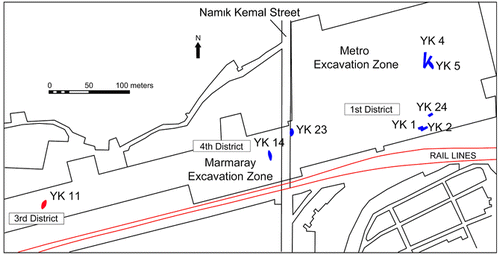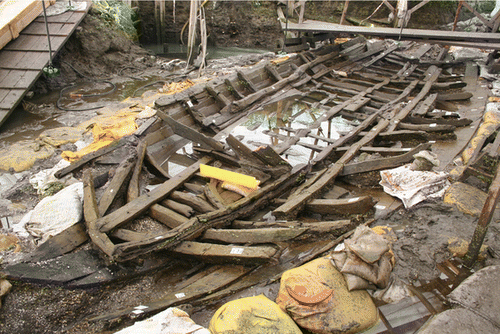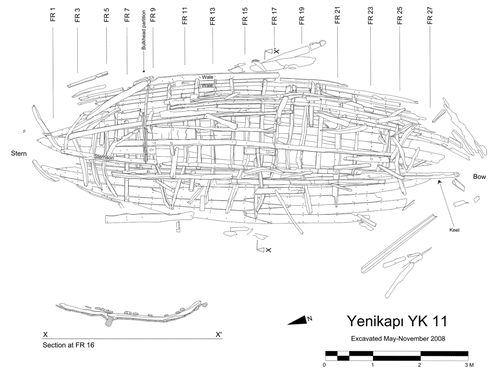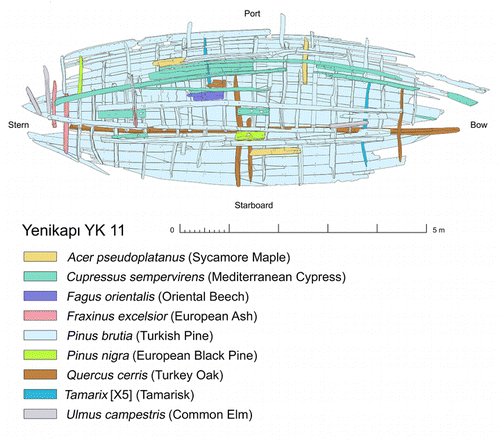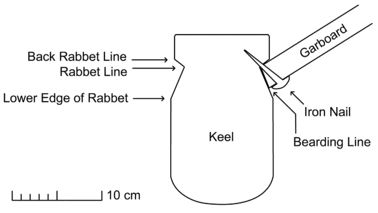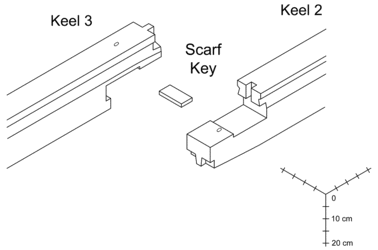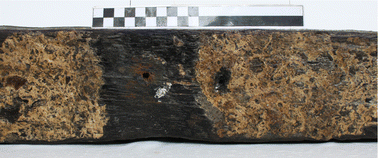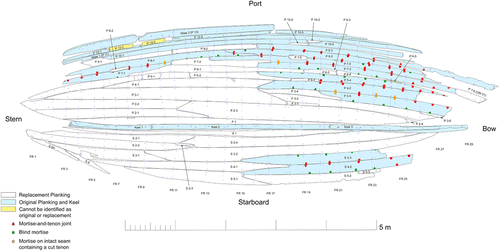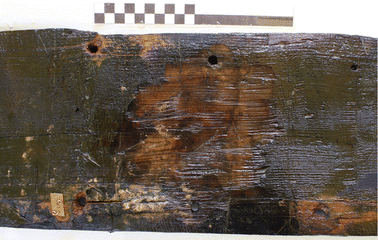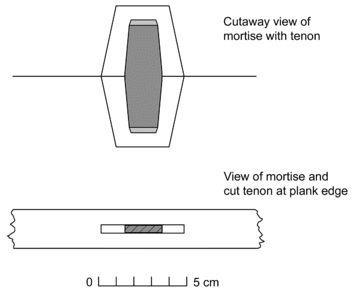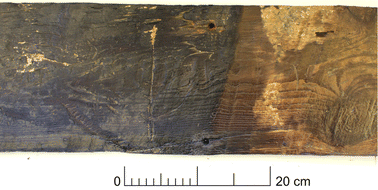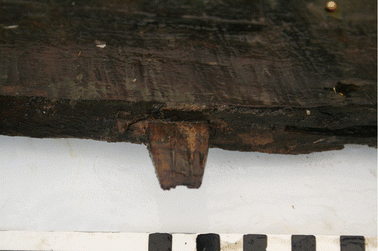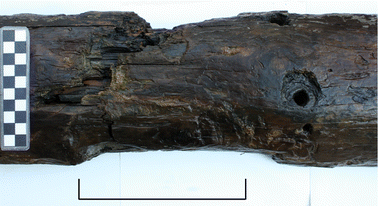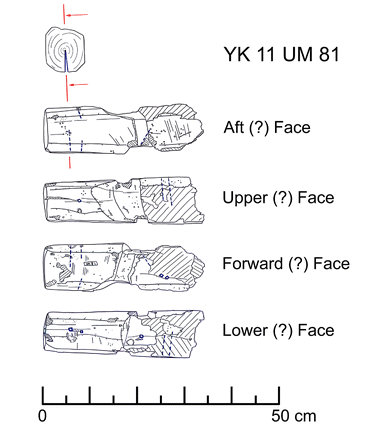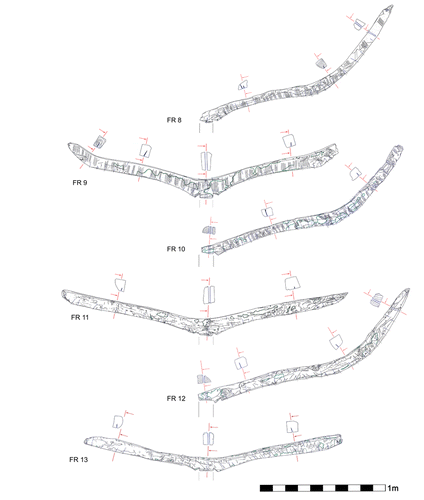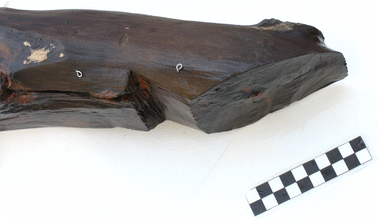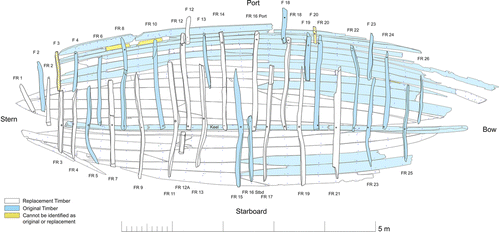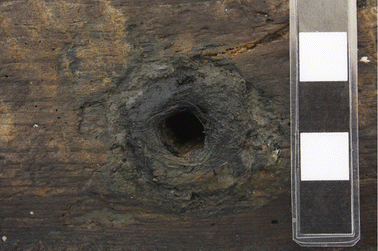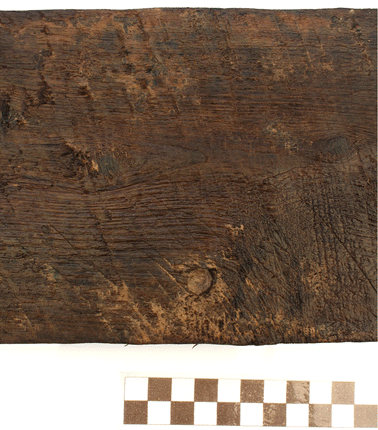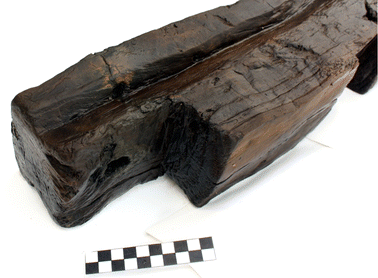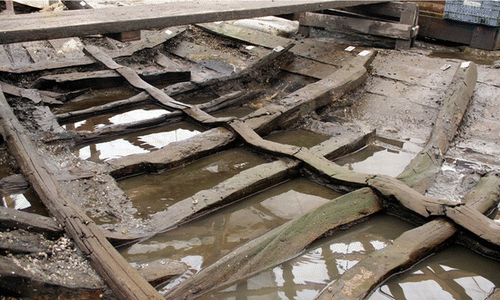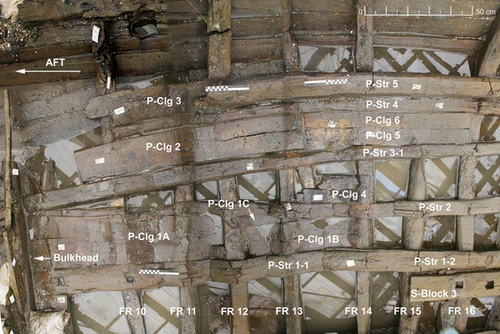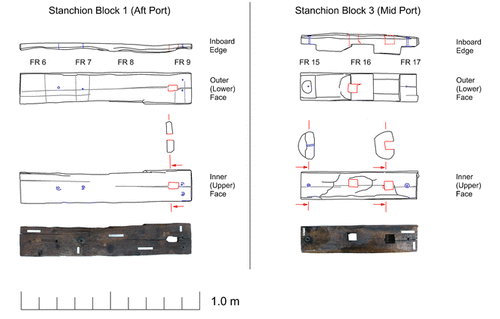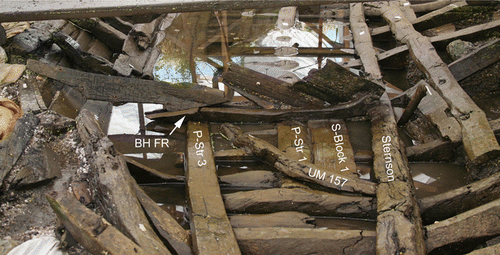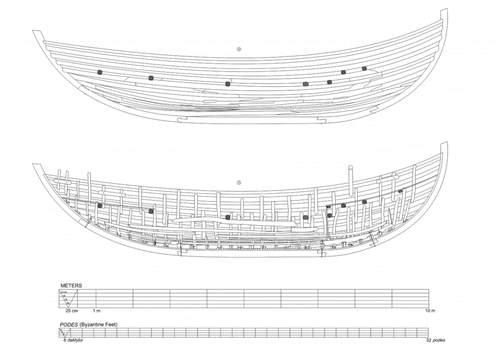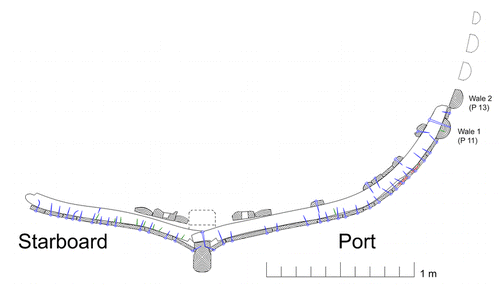Abstract
YK 11, a small, heavily repaired merchantman, was one of 37 Byzantine shipwrecks excavated at Yenikapı in Istanbul, Turkey. This 7th‐century hull, abandoned in the harbour as a derelict, was studied by archaeologists from the Institute of Nautical Archaeology. Originally built with mortise‐and‐tenon edge joinery, the ship had undergone a series of significant repairs over its lifetime. Repairs included the replacement of planking as well as framing. Although the repaired vessel exhibits evidence of both shell‐first and skeleton‐first shipbuilding techniques, detailed study of the hull remains indicates that the ship was initially designed and built as a primarily shell‐based vessel.
抽象
耶尼卡皮11号沉船 (YK11) 的船体:君士坦丁堡狄奥多西港出土的7世纪商船
YK11是一艘经过深度修复的商船, 属于在土耳其伊斯坦布尔耶尼卡皮发现的37艘拜占庭沉船-一。海洋考古研究所的考古学家对这艘被-为废弃物遗弃在港口的7世纪船只的船-进行了研究。该船原以榫卯法拼接船壳, 在其使用期间经历了多次大修。这-修缮包括替换船壳板和肋骨。尽管这艘经过修复的船只显示其存在使用船壳法和骨架法两种构造技术的迹象, 但针对船-遗存的细节研究表明该船最初是按照船壳法设计与建造的船舶。
关键词:耶尼卡皮, 沉船, 7世纪, 船壳造船法, 修复, 拜占庭
耶尼卡皮11號沉船 (YK11) 的船體:君士坦丁堡狄奧多西港出土的7世紀商船
YK11是一艘經過深度修複的商船, 屬于在土耳其伊斯坦布爾耶尼卡皮發現的37艘拜占庭沉船-一。海洋考古研究所的考古學家對這艘-作爲廢棄物遺棄在港口的7世紀船只的船-進行了研究。該船原以榫卯法拼接船殼, 在其使用期間經歷了多次大修。這-修繕包括替換船殼板和肋骨。盡管這艘經過-複的船只顯示其存在使用船殼法和骨架法兩種構造技術的跡象, 但針對船-遺存的細節研究表明該船最初是按照船殼法設-與建造的船舶。
關-詞:耶尼卡皮, 沉船, 7世紀, 船殼造船法, 修複, 拜占庭
Abstracto
El casco del naufragio de Yenikapi YK11: una embarcación mercante del puerto de Teodosio en Constantinopla
YK11, un mercante pequeño, reparado en múltiples ocasiones; fue uno de los 37 naufragios bizantinos excavados en Yenikapi, Estambul, Turquía. Este casco del siglo VII, abandonado en el puerto como derrelicto, fue estudiado por arqueólogos del Instituto de Arqueología Náutica. Originalmente construido con el sistema de ensamblaje de mortaja y lengüeta en los cantos de la tablazón, el barco experimentó una serie de reparaciones significativas a lo largo de su vida útil. Las reparaciones incluyeron el remplazo de tracas, así como de cuadernas. Aunque la embarcación reparada exhibe evidencias de ambas técnicas de construcción, casco previo y esqueleto previo, el estudio detallado de los restos del casco indica que fue inicialmente diseñado y construido como primordialmente de casco previo.
Palabras clave: Yenikapi, naufragio, siglo VII, construcción a esqueleto previo, reparaciones, Bizantino.
ملخص

The copyright line for this article was changed on 23 January 2020 after original online publication.
In preparation for the construction of the Marmaray Project, a major extension of the Turkish State Railways, the Istanbul Archaeological Museums began conducting salvage archaeological excavations at Yenikapı in Istanbul, Turkey, in 2004. These excavations, concluded in 2013, yielded tens of thousands of artefacts ranging in date from the Neolithic to the Late Ottoman period (Asal, Citation2007; Gökçay, Citation2007; İstanbul Arkeoloji Müzeleri, Citation2011; Kızıltan, Citation2013). The most extensive finds from the site are those associated with Constantinople's Theodosian Harbour, one of the primary harbours serving the Byzantine capital between the late 4th and 15th centuries AD (Mango, Citation1986: 121; Müller‐Wiener, Citation1994: 9–10; Pulak et al., Citation2015: 39–42). During this period, silts deposited by the Lykos River (Bayrampaşa Deresi) and marine sand deposited during storms filled the harbour, such that its usable area decreased over time (Janin, Citation1950: 219; Berger, Citation1993; Pulak, Citation2007: 203–204; Perinçek, Citation2010: 207–208, 210–211). Based on the writings of Petrus Gyllius, the harbour area had been filled in completely by the 16th century (Ball, Citation1988: 201). Harbour‐related finds at the site include the remains of piers and other harbour installations, loose ship timbers and ships’ equipment, and 37 well‐preserved shipwrecks of 5th‐ to 11th‐century AD date (Kızıltan, Citation2013: 3–4; one of these, YK 28, may be part of YK 27, which would revise the total found to 36 shipwrecks: see Kocabaş, Citation2015: 23).
The shipwrecks and other organic material found at Yenikapı, buried in sediments below the water table, are exceptionally well preserved. The Istanbul Archaeological Museums’ staff identified the wreck locations and removed the sediment overburden and artefacts associated with the shipwrecks, after which each ship was allocated for further study by specialists. Eight of the site's 37 shipwrecks were allocated for study by a small international team under the direction of Cemal Pulak, Associate Professor at Texas A&M University and Vice‐President of the Institute of Nautical Archaeology at Texas A&M University (INA). These eight ships, ranging in date from the early 7th to late 10th century AD, comprise six round ships or merchantmen (YK 1, YK 5, YK 11, YK 14, YK 23, and YK 24) and two long ships or galleys (YK 2 and YK 4). Pulak's team, including the author, documented and removed these eight ships from the construction zone at Yenikapı between July 2005 and December 2008 (Pulak, Citation2007; Ingram and Jones, Citation2011; Pulak et al., Citation2013; Pulak et al., Citation2015). The remaining ships at the site were allocated for study by a team from Istanbul University's Conservation Department of Marine Archaeological Objects under the direction of Ufuk Kocabaş (Başaran et al., Citation2007; Kocabaş and Özsait Kocabaş, Citation2007; Kocabaş, Citation2008; Citation2010; Citation2012a; Citation2012b; Citation2015; Özsait Kocabaş, Citation2012; Türkmenoğlu, Citation2012).
Shipwreck YK 11
The hull designated as YK 11 is the westernmost shipwreck excavated at Yenikapı, located within grid squares J88–89 and K88–89 in the Third District of the Marmaray portion of the excavation, near the western end of the Theodosian Harbour (Fig. 1). It was first identified by staff of the Istanbul Archaeological Museums in late 2005 and partially uncovered in January 2006. At that time it was assessed to be a 7th‐century shipwreck by Pulak, who then proceeded to take on the excavation and conservation of the shipwreck with funding provided by INA and Texas A&M University and additional in‐kind support by the Gama‐Nurol Partnership. Shipwreck YK 11 has been alternately referred to as the Yüzada wreck, having been found near the Yüzada (‘Plot 100’, Second District) area of the excavation site, and as MRY 5, the fifth wreck found on the Marmaray portion of the excavation site. Archaeologists identified other significant finds near the western end of the harbour, including what is possibly the only known portion of the city's Constantinian wall, a vaulted brick tunnel, workshops (possibly for leatherworking), and an 11th‐century hypogeum, causing the Regional Protection Board to declare that this area would be preserved for use as an archaeological park (Gökçay, Citation2007: 172–174; Karamut, Citation2007: 13). Due to the resultant shift in construction activities away from the YK 11 area, the partially exposed hull was reburied in situ after March 2006, allowing archaeologists to focus on documenting and dismantling shipwrecks farther east, in the site's active construction zone.
The YK 11 shipwreck was first fully exposed in early 2008; the INA team began work with the hull in May 2008, completing the on‐site work in November 2008. The methodology followed by the INA team in the mapping, recording, and dismantling of the Yenikapı shipwrecks has been described in detail by Pulak et al. (Citation2015: 42–45; see also Ingram and Jones, Citation2011: 10–13). The post‐excavation documentation of the YK 11 hull remains was conducted by the author between June 2009 and April 2012.
The hull of YK 11 and associated scattered fragments covered an approximately 5 × 10m area; the wreck itself was 9m in preserved length and 3m in preserved breadth. Radiocarbon analysis indicates that the ship was most likely built in the second quarter of the 7th century AD, with repairs made on multiple occasions later in that century (Table ). The shipwreck was located in a viscous, muddy layer of sediment with shell inclusions, at a depth of 1.7–2.0m below present‐day sea level. The nature of the sediment surrounding the hull is unlike the thick layer of sand farther east in the First District and Metro area, from which most of the other shipwrecks at Yenikapı were recovered (Perinçek, Citation2010: 206–208).
Table 1. Radiocarbon analysis results for shipwreck YK 11. All samples analysed by The University of Georgia, Center for Applied Isotope Studies. Dates calculated using OxCal 4.2
The presence and location of damage from ship‐worms, including Teredo navalis (teredo) and Limnoria spp. (gribble), and the distortion and displacement of some YK 11 timbers indicate that this ship did not sink in a sudden, catastrophic event that would have resulted in its quick burial under protective sediment. Rather, this dilapidated, heavily repaired vessel was more likely abandoned as a derelict in the neglected western corner of the Theodosian Harbour, an area that was quickly becoming unusable by larger ships due to increasing siltation. After the ship had been abandoned, and no doubt stripped of any useful timber, it slowly settled into the viscous mud and was inundated. The area around the ship continued to be used by fishing boats and other small vessels, as evidenced by several punting poles, oar blades, and oar handles found sticking upright in the mud around YK 11.
Analyses by the Istanbul Archaeological Museums of a variety of artefacts found in and around the shipwreck, including sherds of amphoras and other pottery, broken terracotta oil lamps, and various objects of bone, glass, and metal, confirm that this area of the harbour had been used for dumping in the 7th and 8th centuries AD. While these scattered artefacts are not necessarily associated with the shipwreck and are thus of limited value in helping to date the vessel, a folded lead seal found within the ship matches a design used in imperial seals between AD 610 and 695 (Seibt, Citation1987: 36–37; Nesbitt, Citation1991: 2–3), providing a terminus post quem of c.AD 610 for the abandonment of the vessel.
The hull remains
Approximately 40% of the wooden hull of YK 11 was preserved, most of it in excellent condition (Figs 2). The hull had settled on the floor of the harbour with a slight list to port.Footnote1 As a result, the port side of the ship was preserved up to the second wale, just above the first level of through‐beams, while the starboard side was preserved only to the turn of the bilge. Most of the extant elements of the hull were found in situ or suffered only minor displacement. In addition, nearly 200 scattered wooden fragments, labelled ‘UM’ for unidentified member, were found near the hull; several of these were later identified as specific elements of the ship's construction that had been displaced. The ship was built predominantly of softwoods, in particular Turkish pine (Pinus brutia) and Mediterranean cypress (Cupressus sempervirens) (Fig. 5; wood species identification by Nili Liphschitz, Institute of Archaeology, The Botanical Laboratories, Tel Aviv University; Liphschitz, Citation2015: 615–616). The extant hull remains are presented here by type; a summary of the YK 11 catalogue is presented in Table .
Table 2. Summary of the YK 11 Catalogue
Keel
The tripartite keel of YK 11 consists of three scarfed timbers of Quercus cerris (Turkey oak) preserved in situ for a total length of 7.94m (Fig. 6, Table ). The forward and aft portions of the keel are gently curved while the central (and longest) portion is approximately straight. The aft (Keel 1) and central (Keel 2) portions are complete and largely intact; the forward portion (Keel 3) is incomplete, its forward end broken and eroded. All three keel timbers are well preserved with most of their original surfaces. In form, there is only slight hogging to Keel 2 and distortion of its forward scarf, and there is distortion of the aft scarf of Keel 1. Each of the three keel timbers bears a shallow rabbet cut along the port and starboard faces, starting approximately 30mm below the inner face (Fig. 7). The rabbets, which accommodated the garboards and hood ends of the planking, are 9–15mm in depth and 29–48mm in total width.
Table 3. Dimensions of YK 11 keel timbers at well‐preserved areas
The keel timbers were entirely lacking in wooden fasteners; neither tenons nor treenails were present. Three types of iron fastener were documented on the keel timbers: bolts at the keel‐scarf joints, short nails along the rabbets (for the attachment of garboards and strake hood ends), and longer nails on the inner (upper) face (for the attachment of frames). The iron fasteners of YK 11 had been reduced mostly to slushy ferrous sulphide; concretions preserving the form of nail or bolt heads were very rare. With the exception of keel‐scarf bolts, there were no fasteners on the outer (lower) face of the keel.
The three keel timbers were joined by well‐preserved, keyed hook scarfs, 0.24–0.27m in length (Fig. 8). Similar scarfs have been observed on other Late Roman and Byzantine shipwrecks (e.g., Dramont E: Santamaria, Citation1995; Yassıada 1: Bass and van Doorninck, Citation1982; Tantura E: Israeli and Kahanov, Citation2014; Tantura F: Barkai and Kahanov, Citation2016), including many of the Yenikapı shipwrecks (Kocabaş, Citation2015; Pulak et al., Citation2015). Only the forward end of Keel 3, which is broken and eroded, did not bear evidence of a similar scarf. These hook scarfs would have fastened the elements of the keel and the sternpost together, locked in place with a small, rectangular, wooden key pressed up against the vertical step in the scarf table. YK 11's preserved scarf keys are of Turkey oak at the bow and European black pine (Pinus nigra) at the stern. The scarf joint was further reinforced with a 16mm‐diameter iron bolt, driven from the hull exterior, that extended through the keel scarf, an associated floor timber, and the stemson and sternson. Evidence on Keel 2 indicates a bolt with a shallow, domed head, 36mm in diameter, that was not countersunk into the keel; a small ring of grass‐like fibres formed a seal between the bolt head and the keel's outer surface.
The port, starboard, inner, and scarf surfaces of the keel had been payed with pitch, now brownish‐yellow in colour and 2–4mm thick (the term pitch will be used in this article, although some of the pitch may actually represent several coats of wood tar). Multiple applications of pitch during the life of the vessel are evidenced by a distinct pitch line on the sides of the keel at the bearding line and heavy pitch between frame locations on the keel's inner surface (Fig. 9). Thin pitch was observed in some parts of the rounded outer face, but it was poorly preserved due to wear and damage throughout this surface.
Planking
The well‐preserved planking of YK 11 comprises 58 distinct elements in a total of 17 strakes: 6 strakes on the starboard side, extending from the keel to the turn of the bilge, and 11 strakes on the port side, extending from the keel to just below the second wale (Fig. 10). Most of the planks are complete, and approximately half of the extant planks are both complete and intact. Plank seams toward the extremities had opened up slightly, exposing plank edges, and parts of the upper strakes, above strake nine on the port side, had slipped down behind lower strakes. The overall condition of these planks is excellent, with most exhibiting original surfaces and surface treatments, well‐preserved tool marks, and caulking along plank edges. Nearly all of the planking is of Turkish pine; only two pieces, both small repair pieces, are of Mediterranean cypress.
The planking of YK 11 includes planks that were part of the ship's original construction and planks that were later repairs or replacements (Table ). Whether a plank is an original or repair piece is determined through several factors, the most important being the matching of fasteners on each plank with each extant frame. Both types of planking—original and repair—may be further divided into two subgroups. Original planks include planks below the waterline, edge‐joined with mortise‐and‐tenon joints, and planks above the waterline, which were not edge‐joined, beginning with strake ten (P 10) in the bow and strake nine (P 9) in the stern. Repair or replacement planks include graving pieces, which fill a (usually) small gap along one edge of a strake, and larger replacement planks, which span the width of an entire strake. Disregarding the 11 graving pieces, 28 of the ship's 47 extant planks (60%) were replacement planks (see Fig. 10), including the port and starboard garboards as well as nearly all bottom planking abaft midships, the latter perhaps indicative of repetitive beaching of the vessel or shipworm damage. This number does not necessarily represent the ratio of original‐to‐repair pieces in the entire hull at its abandonment, as the upper portion of the YK 11 hull, which is less extensively preserved, exhibits proportionally fewer repairs than the bottom of the hull. Nevertheless, the extent of repair to the planking of this hull is significant.
Table 4. Overview of YK 11 planking
The YK 11 planks are plainsawn boards with edges dubbed to form with an adze, at times roughly; plank edges are generally perpendicular to the plank face. Dubbing is rare along the planks’ inner face, although patches of surface dubbing were observed at some scorched inner surfaces near the ship's extremities (Fig. 11). Due to the extent and nature of the repairs, complete plank lengths vary significantly (see Table ). Original plank lengths at the time of the ship's construction are difficult to ascertain, first because so few of the original planks are complete, and second because even complete planks appear to have been cut down for repairs. Widths of original planks range from 65 to 210mm, while replacement planks—some of which could be replacing two strakes of original planking—reach up to 334mm in width. Thickness of the planks is more consistent, with overall average thicknesses of 20–25mm; the shorter, original planks between the two wales (P 12) are slightly thinner, with an average thickness of 18–23mm.
Original planking below the waterline was edge‐joined with small, unpegged mortise‐and‐tenon joints; 11 such planks were preserved, primarily in the forward half of the ship. Similar mortise‐and‐tenon joints are present on the 7th‐century Yassıada (Bass and van Doorninck, Citation1982: 55–56, 82), Saint‐Gervais 2 (Jézégou, Citation1983: 47; Pomey et al., Citation2012: 265), and Pantano Longarini shipwrecks (Throckmorton and Throckmorton, Citation1973: 263). Edge fastening ceased above strake eight (P 8) in the stern and strake nine (P 9) in the bow. Original planks at this transition have mortise‐and‐tenon joints along their lower edges but not along their top edges; edge fastening ceased in a similar manner on the 7th‐century Yassıada ship (Bass and van Doorninck, Citation1982: 59). These 11 original planks retained evidence of 87 mortise‐and‐tenon joints. Mortises, chisel‐cut without the aid of drilled pilot holes, are on average 47mm in width, 5mm in thickness, and 40mm in depth (Fig. 12). Despite being nearly twice the size of YK 11, the 7th‐century Yassıada ship exhibited nearly identical dimensions in its mortises (Bass and van Doorninck, Citation1982: 55). Centre‐to‐centre spacing between mortises is highly variable, from 0.28 to 0.65m, with an overall average spacing of 0.45m.
Due to the large number of replacement strakes and graving pieces, many of the ship's mortise‐and‐tenon joints were no longer functional by the time the ship was abandoned (see Fig. 10). On plank seams in which the abutting plank was a replacement, the mortises of the original plank were left ‘blind’, either containing a cut or broken half‐tenon or fragments of a tenon, or having been filled in with pitch. Of the 87 mortise locations identified on YK 11, 32 (37%) were blind, lacking a corresponding mortise on the abutting plank. Even on seams for which both original planks are preserved, damage, often from Teredo navalis, had led to the cutting out of some mortise‐and‐tenon joints, subsequently replaced with a graving piece.
Tenons or fragments thereof were found in 61 of the 87 mortise locations; five of these tenons were intact and complete. With average dimensions of 64 × 21 × 4mm, the tenons were much smaller than their mortises in terms of width and depth but were often wedged tightly in place by their thickness. Well‐preserved mortise‐and‐tenon joints indicate that much of the remaining space along the sides of the mortise was filled in with pitch and grass‐like fibres. Of 48 tenons sampled, 43 (90%) are Kermes oak (Quercus coccifera), four are Turkey oak, and one is Sessile oak (Quercus petraea).
Unpegged mortise‐and‐tenon joints, as found on YK 11 and other ships of similar date at Yenikapı and elsewhere in the Mediterranean, do not offer the same contribution to hull integrity as the pegged mortise‐and‐tenon joints seen in earlier hulls (e.g., the Kyrenia shipwreck: Steffy, Citation1985). The YK 11 mortise‐and‐tenon joints only restricted movement in two directions: they prevented relative movement between planks in the vertical direction (in other words, they maintained plank edge alignment), and they prevented longitudinal shifting along the plank seam (although this contribution is diminished by the small size of the tenon relative to the mortise). Since these mortise‐and‐tenon joints are not locked in place with transverse pegs, they provided only minimal resistance to the separating or opening of plank seams. Nevertheless, frictional resistance of the tenon in the mortise made the edge‐joined planks of YK 11 somewhat more difficult to separate during the 2008 dismantling of the hull.
A second form of edge fastening observed in the YK 11 planking is the use of a transverse iron nail to fasten a plank tip to the plank below it. This method of edge fastening plank tips is present at five locations in the extant YK 11 planking: it is used in two cases on replacement planks, and in three cases on original planking (one scarf tip and two drop strake ends). Securing plank tips in this manner has been practised since the Classical period, observed on the Kyrenia (Steffy, Citation1985: 78–81) and Nemi ships (Ucelli, Citation1950: 152–153), and continued to be used well into the Byzantine period, observed on the 7th‐century Yassıada (Bass and van Doorninck, Citation1982: 59) and 11th‐century Serçe Limanı ships (Bass et al., Citation2004: 107–108).
It is noteworthy that the securing of the plank tip with a transverse iron nail is observed in the only preserved original scarf in the edge‐joined planking, a gently curving S‐scarf in strake P 8, near midships (length 0.69m; Fig. 13). This scarf was also edge‐joined with a mortise‐and‐tenon joint along the central portion of the scarf. Remaining scarfs throughout the YK 11 planking are associated with one or more replacement planks; these scarfs are usually 0.30–0.60m in length, covering two or three frame stations. During the addition of replacement planks, the shipbuilder made an effort to place scarf tips or ends at frame locations so that they could be nailed directly to the frames, resulting in a wide variety of scarf shapes.
Short iron nails, up to 80mm in length, fastened the garboards to the keel (see Fig. 7). Because both the port and starboard garboards of the ship had been replaced, only approximately one‐half of the rabbet nail holes on the keel have a corresponding nail hole on the extant garboard; the other nail holes represent abandoned nail holes from the original garboard plank. No mortise‐and‐tenon joints were used at any time for affixing the garboards to the keel. Excluding abandoned nail holes, the garboard nail spacing averaged 0.29m, nearly twice the spacing of the garboard nails of Saint‐Gervais wreck 2 (0.15m; Jézégou, Citation1983: 46). It is noteworthy that the replacement garboard planks were also nailed into the keel rabbet in the same manner as the original garboards, even though they could have been fastened only to the framing at the time of the repair.
Hood ends are preserved on nine replacement planks and one original plank; these were fastened to the keel, stem, or sternpost of the ship with short iron nails driven through drilled pilot holes. A moderate inward bevel facilitated a tighter interface with the keel or endposts. In two instances, a graving piece (P 2–4, P 3–6) forms part of the hood end at the ship's bow.
Score marks, cut with a scriber or other sharp blade, are visible along one or both edges of a frame at nearly every frame location on the original edge‐joined planking. Although relatively rare and very faint, score marks are preserved at some futtock positions on strake ten (P 10), a strake lacking edge fasteners just below the first wale (P 11). Score marks are also present on some replacement planks, located at edges of some replacement frames (Fig. 14).
Pine pitch or pitch stain usually covers the plank exterior and the inner plank surfaces between frames. Pine pitch was a known deterrent to shipworm (Theophr. Hist. pl. 5.4.5) and helped seal the hull to prevent leakage along plank seams. Faint pitch on the lower face of original frames at original planks suggests that the outer face of the frame had a layer of pitch applied to it prior to its installation in the hull. This would have provided the protection of pitch to an area vulnerable to rot while keeping other surfaces pitch‐free and easier to work with until the construction could be completed, at which point the entire interior of the vessel could be payed with pitch. A similar application was noted on the late 4th‐ or early 5th‐century Yassıada ship (van Doorninck, Citation1976: 124). Pitch was especially thick along YK 11 frame edges, indicating re‐paying of pitch over the hull on several occasions.
There is evidence for the use of both laid (applied) and driven caulking in the hull of YK 11. Up to 5mm thick, the caulking is composed of short, chopped segments of grass‐like fibres heavily intermixed with pitch. Because it was easily washed away, both prior to and during excavation, caulking is rarely preserved where plank seams have opened up or been otherwise exposed, most often at hull extremities. That caulking was found inboard of intact tenons proves that, during the initial construction of the vessel, caulking was applied to edge‐joined plank seams during assembly (Fig. 15). There is also ample evidence that thick, fibrous caulking was driven into seam gaps during the addition of graving pieces or replacement planks, or during routine maintenance. In the driven caulking, grass‐like fibres (which were longer and better preserved than those of the laid caulking) were generally oriented perpendicular to the plank seam (Fig. 16). Along some edge‐joined plank seams, in which both abutting planks were original, some tenons were cut and caulked over while other tenons along the same seam remained intact and uncut, indicating the re‐caulking of deteriorated patches rather than a blanket re‐caulking of all original, edge‐joined seams later in the life of the vessel. This resulted in a mix of laid and driven caulking, and cut and intact tenons, along some original plank seams.
Mortise‐and‐tenon construction is generally considered incompatible with driven caulking (Bass and van Doorninck, Citation1982: 72). However, laid caulking has been observed in some edge‐fastened hulls, including the early 5th‐century Port‐Vendres 1 and Dramont E ships (Liou, Citation1974: 422, fig. 7; Santamaria, Citation1995: 149–150; see also Bockius, Citation2006). Evidence from these shipwrecks, in addition to YK 11 and other edge‐joined ships found at Yenikapı (Pulak et al., Citation2015), challenges the conventional belief that the general presence of caulking indicates skeleton‐based construction (Pomey et al., Citation2012: 297); the caulking must be analysed to determine whether it was driven or laid. On YK 11, fibrous caulking was also used to fill in knot holes, damaged areas, holes from pulled nails, and other irregularities along plank edges, some of which were surprisingly large, such as the 20mm‐thick wad between plank S 2‐2 and graving piece S 2–3 (Fig. 17).
Char‐bending was extensively used to help attain the desired form of the planks at the complex curves at the ship's extremities; it was observed on nearly every plank at the extremities, including both original and replacement planking. Char‐bending continues to be used in traditional shipbuilding in areas including Indonesia and Pakistan (Greenhill, Citation1957; Hawkins, Citation1982), and possible evidence of the technique has been observed on several 1st‐millennium‐AD shipwrecks, including the Dramont E (Santamaria, Citation1995), Tantura A (Kahanov and Royal, Citation1996), Tantura E (Israeli and Kahanov, Citation2014), Tantura F (Barkai and Kahanov, Citation2007), and Dor D (Kingsley, Citation2002) ships and Yenikapı shipwrecks YK 14 (Jones, Citation2015, Citation2017), YK 17 (Kocabaş, Citation2008; Türkmenoğlu, Citation2012), and YK 23 (pers. obs.), among others. On YK 11, this technique is characterized by a scorching of the plank's inner face, resulting in a surface that is black or darker in colour and much harder than the remaining planking; in some areas, the wood is charred, with a carbonized and cracked surface (see Fig. 14). Charred or scorched surfaces in some areas were later trimmed with an adze, perhaps to create a smoother surface; similar dubbing was noted on charred plank surfaces of the Kyrenia ship (Steffy, Citation1985: 84).
Wales and through‐beams
Two in situ wales were preserved on YK 11, port strakes P 11 (Wale 1) and P 13 (Wale 2); both wales are half‐logs of Turkish pine, with bark removed from the rounded outer face. Based on evidence from disarticulated futtocks, the ship probably originally possessed four wales on either side. Neither in situ wale is complete. Wale 1 (P 11), with one original end, is 7.24m in length, nearly 7m of which remained intact. The preserved length of Wale 2 (P 13), broken into three pieces, is 4.28m; neither end is original, and this wale exhibits more extensive damage along its exposed top edge. The wales (maximum width 0.16–0.17m, maximum thickness 0.08m) taper in the direction of growth; as in the Yassıada 1 ship (Bass and van Doorninck, Citation1982: 78–79), the two extant YK 11 wales were installed with the direction of growth in opposite directions. Upper and lower edges of the semi‐circular timbers were dubbed flat with an adze in some (but not all) areas.
There is no evidence of the use of edge joinery in either the in situ wales or the disarticulated wale‐like fragments. The after end of Wale 1 (P 11) terminates in a flat scarf, 0.38m in length; the wale timber to which it was scarfed was not preserved. A similar scarf was observed on the wale of the Serçe Limanı hull, although it was nailed together (Bass et al., Citation2004: 112); there is no fastener within the YK 11 wale scarf. The relatively weak scarf on the YK 11 wale, spanning two frames and fastened only to framing, likely reflects the shift to pre‐erected framing above the waterline.
While there are no clear score marks discernible on Wale 2 (P 13), there are score marks in several areas on Wale 1 (P 11), at the location of some replacement framing as well as along the edge of some original framing, almost exclusively first futtocks (those paired with floor timbers). This suggests that Wale 1 had been installed before (at least) some of the first futtocks were installed, but had not been in place when most of the half‐frames were installed.
The two in situ wales were separated by a through‐beam strake (P 12), a series of planks alternating with gaps that would have accommodated the lowest level of through‐beams (Fig. 18). Although none of the YK 11 through‐beams was preserved in situ, gaps in the through‐beam strake indicate the presence of at least three through‐beams, 0.10–0.15m sided and 0.10m moulded. On the in situ wales, obliquely driven nails, notches or wear to wale edges, pitch, pressure lines, and outer‐face caulking provide additional evidence of these three as well as two additional through‐beam locations, one of which was above Wale 2 (P 13). The five through‐beams were located toward the bow, just forward of midships (serving as a mast‐partner beam), and toward the stern (three through‐beams at two different levels).
The through‐beams would have been locked in place with iron nails driven obliquely through the wale edges and into the top or lower face of each through‐beam; as such, the through‐beams provided transverse strength to the hull and tied the wales together, thus integrating key elements of longitudinal strength above the waterline. A similar structure of wales and through‐beams is cited as a significant source of longitudinal strength on the Port Berteau II ship (Rieth et al., Citation2001: 56). The YK 11 through‐beams were not attached to the comparatively flimsy through‐beam strake; these planks were too weak to provide any structural support and served primarily to fill the gaps between through‐beams and wales.
Caulking and pitch outlines on the outer face of the wales at some through‐beam locations indicate that caulking was driven into gaps between the wale and through‐beam then sealed with pitch (Fig. 19). Pressure marks and discoloration on the inner and outer faces at the butt ends of planks in the through‐beam strake (strake P 12) suggest furthermore that the through‐beam itself had rounded or chamfered edges and was notched on the sides to accommodate plank ends. This form and method of attachment of the through‐beams was confirmed by a disarticulated fragment of a through‐beam that almost certainly belonged to the ship (UM 81). Of Mediterranean cypress, UM 81 is the outboard projecting end of a through‐beam, preserved for a length of 0.35m (Fig. 20). Its maximum dimensions are 0.10m sided by 0.10m moulded, tapering slightly toward its original outboard end. UM 81 has chamfered edges, and staggered notches on each face would have accommodated the wales and butt ends of through‐beam‐strake planking. While its original location in the hull remains unknown, the staggering of notches indicates that this through‐beam was either from the starboard bow or port stern of the vessel.
An oblique nail hole in the lower‐face notch of UM 81 confirms the method of through‐beam attachment observed in the in situ wales (Fig. 21). UM 81 indicates that at least some through‐beams were fastened with one rather than two nails (one per wale). Other nail holes on UM 81, outboard of the planking, are of unknown function, while nail holes on the through‐beam's side may have been used to secure part of a bulkhead or inner partition.
Frames
The framing of YK 11 follows a pattern of floor timbers alternating with paired half‐frames. Archaeologists recorded 37 frame timbers representing 26 frame stations on YK 11 (Table ); nail holes on the keel and planking indicate four additional frame stations in the bow where framing was not preserved (FR 27–FR 30), for a total of 30 frame stations. Some of the frames were disarticulated timbers later matched to the YK 11 hull planking on the basis of fastening patterns.
Table 5. Dimensions of YK 11 framing
Two types of frame timbers made contact with the keel (Fig. 22): floor timbers, which span the lower portion of the hull, with upper ends (wrongheads) extending just beyond the turn of the bilge; and half‐frames, which span the entire width of the keel and extend up one side of the ship, either to or above Wale 1 (P 11). The spacing between frames on the keel is variable and ranges from 195 to 412mm, with an average spacing of 307mm, close to one Byzantine foot (312mm; Schilbach, Citation1970: 13–16). All of the 13 extant floor timbers and 14 half‐frames were fastened to the keel. Nine futtocks were also identified, including five first futtocks (associated with floor timbers) and four second futtocks (associated with half‐frames). There was also one small reinforcement frame, FR 12A, placed abaft half‐frame FR 12 on the starboard bottom planking.
While frames were generally very well preserved, there was cracking and pressure damage to the inner (upper) surface of many frames at the location of the ship's ceiling. Wood species identification has revealed that the framing was predominantly Turkish pine (70%; see Fig. 5). However, several other wood species are represented, including sycamore maple (Acer pseudoplatanus), European ash (Fraxinus excelsior), European black pine, Turkey oak, tamarisk (Tamarix [x5]), and common elm (Ulmus campestris). Compass timbers, or grown curvatures, were used for nearly every element of framing, and patches of natural, minimally worked surfaces abound (Fig. 23). Most other frame surfaces were dubbed to form with an adze, although many frames had one flat, sawn face, either the forward or the aft face. Triangular limber‐holes, cut into the outer face of the floor timbers and half‐frames outboard of the keel edge, allowed the free passage of bilge water in the bottom of the hull.
Surprisingly, many of the YK 11 frames were found to be replacement frames, presumably for rotten, damaged, or worn‐out pieces (Fig. 24). Excluding reinforcement frame FR 12A, 16 of the 36 extant elements of framing (44%) are replacements, identified after a careful comparison of fastener holes on the frame with those on the keel and corresponding planking. The identification of replacement framing was complicated by the extensive repairs to the ship's planking and the shipwright's habit of reusing old nail holes in the planking for the fastening of replacement framing.
Of the 13 floor timbers identified on YK 11, nine are replacements (69%), no doubt reflecting notable degradation in the bottom of the hull. While most floor timbers terminate in tapering wrongheads, replacement floor timber FR 21 is an exception, notched to accommodate futtocks at its port and starboard ends. Evidence on the keel and sternson indicates that floor timber FR 4 was a replacement for a pair of half‐frames; if so, the alternating pattern of floor timbers and half‐frames was consistent between frames FR 2 and FR 26 at the time the ship was first built.
Fourteen half‐frames at 13 frame stations were identified on YK 11; eight of the 14 half‐frames (57%) are original. Each half‐frame would have been paired with a corresponding half‐frame on the opposite side of the ship; however, only one starboard half‐frame was preserved (FR 16). In half‐frame pair FR 16, the port half‐frame is a replacement, while the starboard half‐frame is original.
Futtocks were placed adjacent, but not fastened, to their respective floor timber or half‐frame, their lengths overlapping by the width of one or more planks. There is no clear pattern to the placement of the futtock, either forward or aft of its associated frame. Nine futtocks were identified on YK 11, five of which were associated with floor timbers (first futtocks). Nail holes or pitch outlines on the planking indicate the locations of eight additional first futtocks on the port side and seven on the starboard side. These curved timbers with tapering wrongheads started just below the turn of the bilge and extended up to Wale 2 (P 13). At least four of the five first futtocks were original to the initial construction of the ship (see Fig. 24).
The four extant futtocks paired with half‐frames (second futtocks) started around Wale 1 (P 11) and extended up the side of the ship to the fourth wale or perhaps to the sheer‐strake, in which case they would also act as top timbers (only two of the four futtocks are complete). Nail holes on the upper strakes of the port side indicate three other second futtock locations. Only two of the preserved second futtocks are original to the initial construction.
The fastening of framing
All framing was fastened to the keel and hull planking with iron fasteners; no wooden fasteners were found. When the ship was built, three floor timbers—FR 4, FR 9, and FR 21—were fastened to the keel with iron bolts at keel‐scarf joints (FR 29, which was not extant, may also have been bolted to the keel). Other frames were fastened to the keel with long iron nails, 0.14–0.17m in length and square in section, driven from the top of the frame; these nails did not extend to the keel's outer face. Without exception, every element of the ship's framing that crossed or contacted the keel was fastened to it. In many cases, there is more than one nail hole at a frame station on the keel, either because the frame had been replaced or because additional nails were added to correct damage or to reinforce the keel‐to‐frame joint. To prevent damage, these nails were driven through drilled pilot holes in the frames; at the locations of floor timbers and some half‐frames, these pilot holes continued into the inner (upper) face of the keel.
Frames were fastened to the hull planking with short iron nails, approximately 0.07m in length, driven from the hull exterior. On any given plank, there are usually between one and three nail holes at each frame station, with as many as four or five nail holes where a frame had been replaced or reinforced. Based on pressure marks on the plank exterior, nail heads, rounded or slightly angular, were 18–23mm in diameter. The nails were first wrapped with a line of grass fibres before being driven into the hull (Fig. 25), the ring of fibres forming a tight seal; this was also noted on some of the nails of the Serçe Limanı shipwreck (Bass et al., Citation2004: 110).
When a replacement frame was installed, the shipwright attempted to minimize the number of holes in the planking by reusing holes from old nails that had been pulled. Nevertheless, numerous abandoned nail holes were identified on the planking; these were filled in, either with grass‐like fibres, or, in one instance, with a small wooden plug, and sealed with pitch. Many such abandoned holes could only be identified after nearly all the pitch had been removed from the inner face of the planking (Fig. 26). In most cases, these filled holes indicate where a frame had been replaced. Abandoned holes were found on nearly all of the original planking and several of the replacement planks, reflecting multiple significant repairs to the hull.
The ship's framing was fastened to the wales with iron nails, 0.10–0.15m in length, usually (but not always) driven from the hull interior; there is no evidence for the use of bolts to fasten the framing to the wales.
Stemson and sternson
A stemson and sternson provided internal support at the keel‐scarf joints. Similar timbers found on the Dor 2001/1, Tantura E, and Tantura F shipwrecks are labelled central longitudinal timbers (Mor and Kahanov, Citation2006; Israeli and Kahanov, Citation2014; Barkai and Kahanov, Citation2016). Based on their location, size, and attachment to the keel, the YK 11 stemson and sternson provided additional support for the ship's spine at the hull ends rather than serving as a primary source of longitudinal stiffness, as seems to be the case on ships in which the securely bolted stemson, sternson, or keelson is larger in section than the ship's spine, as on the Serçe Limanı and Saint‐Gervais 2 ships (Bass et al., Citation2004: 164; Jézégou, Citation1983: 75).
The YK 11 sternson (Fig. 27, 28), labelled KS 1, was notched to fit over frames FR 2–FR 9, mirroring the curvature of Keel 1 (FR 4–FR 9). A similar timber was present toward the preserved end of late 8th‐ or early 9th‐century shipwreck YK 23 at Yenikapı (Pulak et al., Citation2015: 50–51, fig. 12). The YK 11 sternson (2.05m long, 96–109mm sided, 95–135mm moulded between frames) is complete but not intact. The frame recesses, up to 50mm in depth, vary in length from 100 to 170mm, depending on whether the recess accommodated a floor timber or a pair of half‐frames; there is no recess cut for the pair of half‐frames at FR 6.
The sternson was bolted through the scarfed keel and frames at FR 4 and FR 9. It was fashioned from a repurposed, shipworm‐riddled keel of Turkish pine (Fig. 27), and its curvature indicates that the sternson was originally the curving transitional portion of another ship's keel. Its dimensions, rabbets, pressure marks, and holes from iron nails suggest that this previous ship was built similarly to YK 11, with a framing pattern of floor timbers alternating with paired half‐frames.
The well‐preserved stemson differs significantly from the sternson in form, wood species, and dimension (Fig. 29). This complete timber (0.80m long, 82–95mm sided, 37–93mm moulded) tapers toward its forward end. Cut from a large branch of common elm, it retains naturally rounded surfaces on much of its upper and lower faces. Spanning just three frames (FR 21–FR 23), the stemson has one recess on its lower face to accommodate the pair of half‐frames FR 22. The stemson was fastened with long iron nails, driven through drilled holes from the upper face of the stemson, through frames FR 21 and FR 23, into the upper face of the keel. Evidence indicates that the stemson was originally part of the bolt assembly including the original floor timber FR 21; upon its replacement, the floor timber was moved slightly forward and was thus removed from the bolt assembly, along with the stemson, weakening the ship's central assembly at the bow.
Ceiling
The partially preserved ceiling (internal planking) of YK 11 consists of stringers, common ceiling, and sills, that is, crenellated planks that prevented foreign objects from falling into the bilges (Fig. 30).
Stringers
The ship's seven extant strakes of stringers consisted of ten individual timbers fashioned from softwoods, including Turkish pine (six) and Mediterranean cypress (four) (see Fig. 5). Following the convention used in documenting other Yenikapı wrecks, these timbers were labelled stringers in accordance with Steffy's general definition of a stringer as a longitudinal timber fixed to the inner surface of the frames (1994: 281; see also Kocabaş, Citation2015; Pulak et al., Citation2015). The starboard limber strake (C‐Str 1) was preserved in situ, while that of the port side is not extant but is indicated by nail holes on the upper surface of framing. Outboard of the limber strakes, one stringer was preserved on the starboard side (S‐Str 1) and five on the port side (P‐Str 1–5), the topmost port stringer being a thicker clamp opposite the lowest wale.
All the stringers were adversely affected by post‐wrecking pressure damage, with cracking throughout and deep pressure marks at many frame locations (Fig. 31). None of the stringers is intact, and only four of the ten are complete or nearly so; the longest stringer, 5.09m in length (P‐Str 4), is incomplete. Cut from relatively young trunks, the stringers’ upper surfaces are either naturally rounded or, at wider areas, adzed flat, with naturally rounded edges or an adzed chamfer preventing sharp angles which might be easily damaged. Widths vary over the length of the stringer (55–145mm); on average, thicknesses range from 29 to 47mm, but may be up to 65mm. The clamp on the port side (P‐Str 5) is, on average, slightly thicker than other stringers.
With the exception of the limber strake, original stringer ends terminate at frame locations. Each of the first strakes of stringers outboard of the limber strake consists of two stringers joined with a flat vertical scarf, 0.29–0.33m in length (Fig. 32). Each scarf was secured with a single iron nail, driven through the scarf into half‐frame FR 14. Stringers were lightly fastened to the upper surface of the ship's framing with short iron nails, usually with one nail for every third frame (average nail spacing 0.90m). Abandoned nail holes on P‐Str 2 through P‐Str 5 indicate that these had been temporarily removed on one or more occasions to facilitate the replacement of framing. That many such abandoned holes were found between frame locations seems to suggest that the stringers were not always reattached in the same position. Because the nails were driven through pilot holes on the stringers, it is not clear whether the limber strake and the first strakes of stringers, lacking abandoned nail holes, are replacements for older, worn or damaged stringers; this may indeed be the case for the first strakes based on their superior surface preservation.
Two approximately rectangular mortises were cut into the upper face of both P‐Str 1‐1 and P‐Str 2, near floor timber FR 9 and half‐frame FR 10. The FR 9 mortises may be associated with the ship's bulkhead or with a through‐beam near this location; the FR 10 mortises do not appear to be associated with any known construction feature. Recesses along the inboard edge of the limber strake accommodated the stemson as well as the mast‐step, which was not preserved; Pomey et al. (Citation2012: 237) consider the configuration of mast‐step and limber strakes characteristic of a ‘western Roman Imperial’ tradition. A shallow recess on the upper edge of the clamp (P‐Str 5) corresponds to the location of the mast‐partner through‐beam, which was not extant.
Common ceiling
Ten planks of common ceiling, short planks placed between stringers to prevent cargo and ballast from falling between the frames, were preserved in situ. Most of the extant planks were located in the well‐preserved port quarter of the vessel, and all were longitudinally laid (Fig. 33). Because the ceiling planks were fashioned to fill gaps between stringers, there is notable variation in their size and form. Seven of the ten planks are complete or nearly so, 0.27 to 1.22m in length and 0.06 to 0.28m in width; thicknesses, as expected, are relatively consistent, from 22 to 29mm, comparable to that of the exterior hull planking. The common ceiling comprises five different wood species (see Fig. 5); the variation in size, shape, and wood species all indicate that the ceiling was cut from scrap timber.
Nearly every preserved piece of common ceiling was fastened to the upper surface of one or more frames with one or more short iron nails, most of which were driven through pilot holes. Old holes from pulled iron nails, some between frame locations, indicate that the common ceiling, like the stringers, had been temporarily removed to replace the framing below; two planks of common ceiling had been inverted upon reinstallation.
Six of the ten ceiling planks were rectangular or approximately so, with straight edges and flat, blunt‐cut ends at frame locations; the remaining four pieces were irregular in form. One ceiling plank, of Oriental beech, possesses finely cut grooves along its inboard and outboard edges that serve no purpose; the unused grooves and the plank's delicate craftsmanship, otherwise absent on YK 11, designate this as a repurposed piece.
There is no evidence of transverse ceiling, seen on other Byzantine‐era vessels including Yenikapı ship YK 35 (Kocabaş, Citation2015: 31, fig. 26) and the Serçe Limanı ship (Bass et al., Citation2004: 118–119), but loose limber boards may have been utilized in the area around the keel abaft midships. The YK 11 ceiling was not interlocked or bevelled to create a tight seal, and it would have been somewhat uneven due to the difference in thickness between the stringers and common ceiling. As such, this hull was not designed to carry a loose bulk cargo such as grain, although the latter may well have been carried in sacks (Rougé, Citation1966: 78).
Sills
Sills, crenellated planks cut to fit over frames opposite the lowest wale (Fig. 34), are the third element of ceiling. These planks prevented foreign matter from falling between frames into the bilges (cf. Loewen, Citation2007: 161–164). Two such planks were found on YK 11, having been pulled slightly out of their original position (at FR 12–FR 14) and thus labelled as UMs. UM 6 (length 0.63m) is complete, and UM 12 (length 0.36m) is incomplete; maximum widths (between frame notches) are 110–130mm and thicknesses 19–25mm.
The sills were fastened with short iron nails, driven either obliquely through the notched areas into the inner surface of framing or straight down into the upper edge of the clamp upon which they presumably rested, although the clamp is not preserved in this location. An old, abandoned nail hole suggests that UM 6 is a repurposed timber. The most characteristic features of these sills are the recesses cut along their outboard edges, 50–80mm in depth, which allowed the sill to be fitted over frames; variation in depth probably reflects differing moulded dimensions of the individual frames. Similar planks on the Tantura B shipwreck may have been located nearer the turn of the bilge (Kahanov, Citation2000: 153). The location of the YK 11 sills, opposite the first wale (P 11), indicates that the well‐preserved area of ceiling in the hull's port quarter may be representative and the ship's central hold area was fully internally planked to the load waterline.
Stanchion blocks
Six well‐preserved stanchion blocks were found in situ on shipwreck YK 11 (see Figs 30, 35). They were positioned in pairs, parallel to the ship's centreline outboard of the limber strakes, near the bow (spanning frames FR 22–FR 24), amidships (spanning frames FR 15–FR 17), and toward the stern (spanning frames FR 7–FR 9). The six stanchion blocks are cut from softwoods: cypress (3), Turkish pine (2) and European black pine (1); all are complete, and all but one is intact. Similar timbers on the Yenikapı YK 29 and YK 35 (Kocabaş, Citation2015: 21, 23–25; figs 19, 26), Dor 2001/1 (Mor and Kahanov, Citation2006: 281), and Tantura F (Barkai and Kahanov, Citation2016: 14–15) shipwrecks, described as ‘mast‐step sisters’ or ‘lateral sisters’, are only located near midships and are transversely oriented. While their precise function is unclear, these timbers probably held stanchions that supported a longitudinal timber or structure at or near deck level, perhaps the xylokastron or tabernacle seen in 7th‐century depictions of sailing vessels, which provided additional support to the ship's mast (Basch, Citation1991b: 5).
Each stanchion block was fastened to the frames upon which it rested with two to three iron nails. The timbers, approximately rectangular, vary in form and dimension (Table ). The stanchion blocks amidships, cut with deep recesses to fit over framing, are twice as large in moulded dimension as the forward and aft pairs of stanchion blocks. The forward and aft stanchion blocks, similar to stringers in sectional form, are not notched to fit over framing, although areas of the lower surface of some had been dubbed with an adze to accommodate one or more frames. S‐Block 2, bearing several unused sockets and fastener holes, was fashioned from a repurposed timber of unknown function.
Table 6. Dimensions of YK 11 Stanchion Blocks
Each stanchion block has an approximately rectangular mortise in its upper surface (average dimensions 51 × 40mm, depth 34–71mm); the mortise usually extends through the timber's lower surface. Unlike the others, S‐Block 3 has two mortises: the after mortise (aligned with the mortise of the starboard stanchion block amidships) extends through the stanchion block's lower surface, while the forward mortise, located between frames at the timber's maximum moulded dimension, does not. No trace of a stanchion or similar timber was preserved in association with the stanchion blocks. Based on nearly all of the mortises extending through the lower surface of the stanchion blocks, the stanchion or other timber fitted here must have had a tenon at its lower end. There is no evidence of pressure damage on the framing to suggest that any part of these stanchions extended below the lower surface of the stanchion blocks. The mortises in the fore and aft pair of stanchion blocks align with through‐beam locations, and score marks at the edges of the mortise on the forward stanchion blocks reflect the importance of the mortises’ longitudinal placement.
Bulkhead
Part of a bulkhead was preserved in situ on the vessel's port side, toward the stern, between half‐frame FR 8 and floor timber FR 9 (see Figs 30, 36). The bulkhead consists of a frame‐like base (BH FR 1) into which four separate panels were inserted (BH Planks 2–5; Figs 37, 38); all elements were of Turkish pine except the fourth bulkhead panel (BH Plank 5), which was of European ash.Footnote2 The bulkhead base (length 1.04m, maximum moulded 100mm, maximum sided 90mm) is broken yet complete. A chiselled, rectangular groove along the upper face (width 20–21mm, depth 20–37mm) runs the entire length of the timber.
The bulkhead base rested on the sternson, a stanchion block, and the first and third port‐side stringers, with the inboard end of the base covering only half of the sternson's upper face. On its outer face, the base was trimmed to fit over the sternson and the third port‐side stringer; it is also very lightly trimmed down at the location of the first port‐side stringer. Based on its form and position, this bulkhead base could be considered a rider, although it was very lightly fastened and provided little additional stiffening to the hull. The base was fastened to the sternson and the third stringer with a single iron nail each, and the presence of another nail hole on the sternson's inner face, to starboard of the end of the in situ bulkhead base, suggests the presence of a similar bulkhead base on the starboard side of the vessel, perhaps in a configuration similar to that of the paired bulkhead base timbers, also of Turkish pine, documented in the Tantura E shipwreck (Israeli and Kahanov, Citation2014).
Parts of four bulkhead panels, 18–21mm in thickness, were found with the in situ bulkhead base; their diagonal orientation upon excavation reflects slight displacement, their original orientation having been vertical. Panel widths vary from 59–172mm, and all panels are broken at their upper extremity; old fastener holes suggest that two of the four panels had been recycled, perhaps repurposed pieces of common ceiling. The panels were fitted into the groove on the bulkhead base but were not fastened to it; however, a likely through‐beam at this location, between the first and second wales, would have provided a point of attachment for the upper ends of the bulkhead panels.
Yenikapı shipwrecks YK 29 (8th–9th century) and YK 31 (9th century), and the Tantura E shipwreck appear to have possessed similar bulkheads in which the bulkhead base, independent of the ship's framing, was mounted above the ship's ceiling (Kocabaş, Citation2015: 21, figs 19–20; Israeli and Kahanov, Citation2014: 377–378). Grooves cut into the inner faces of floor timbers or futtocks indicate the position of bulkheads on at least five other vessels at Yenikapı: YK 3, YK 12, YK/14, YK 20, and YK 21, all of likely 9th‐ to 10th‐century date (Kocabaş, Citation2008; Citation2015; Pulak et al., Citation2015). Bulkhead panels do not appear to have been preserved on any other ship at Yenikapı. It is unclear whether a bulkhead base mounted above the ship's ceiling, as documented in the YK 11, YK 29, YK 31, and Tantura/E shipwrecks, indicates that the bulkhead was a later addition rather than an original construction feature. Alternately, based on the slightly differing dates of the ships with interior bulkhead bases, this could be an earlier style of bulkhead, or could reflect the structural importance of stringers in these vessels, which may have been interrupted by the placement of the bulkheads in the later ships (as in YK 3, YK 12, YK 14, YK 20, and YK 21).
A second, disarticulated frame‐like bulkhead base, labelled UM 157, was found abaft the in situ bulkhead. Abandoned nail holes on the outer face of UM 157 identify this timber, of European ash, as a repurposed frame; only two iron nails, driven from the inner face, fastened this bulkhead base. UM 157 is almost certainly part of a separate bulkhead on YK 11, although its original location within the hull could not be identified.
Disarticulated timbers
Of the nearly 200 disarticulated timbers and wooden fragments found near YK 11 and assigned a UM label during initial excavation, approximately 85% cannot be definitively placed within the hull. These include pieces that, based on form, size, and other features, have been identified as elements of framing (22), planking or common ceiling (50), wales (12), stringers (8), and small objects used to manage a ship's rigging, including toggles, sheaves, and a block (18); these may or may not have been part of the YK 11 hull or its gear. About one‐quarter (47) of the UM timbers found scattered across the YK 11 excavation area could not be grouped with any particular category, due either to poor preservation or simply a lack of diagnostic detail.
A final group of disarticulated pieces includes 12 wooden objects or fragments thereof that had been used to propel smaller watercraft after YK 11 had become inundated. These are most often pole‐ or handle‐like objects of rounded or ovoid section, often minimally worked branches from which the bark had been removed. Five of the objects in this group represent part of an oar (Fig. 39); all five are Fagus orientalis (Oriental beech), which Theophrastus (Hist. pl. 5.4.4) notes does not decay in water. Nearly half of the pole‐ or oar‐like objects were found upright in the viscous mud surrounding the shipwreck, confirming the shallow nature of the area in which the YK 11 hull was abandoned as well as the area's continued use by smaller vessels, most likely fishing boats.
A mixed construction
As will be demonstrated, ship YK 11 was primarily a shell‐based hull built with a combination of shell‐first and skeleton‐first techniques. Despite the ship's extensive repairs, a careful analysis of the original planking—in particular the mortise‐and‐tenon joints and score marks—aided in determining the initial construction sequence. The presence of mortise‐and‐tenon joints in close proximity to an original frame is a good indication that planking had been assembled before the frame was added. Steffy notes that, based on practical experience, a mortise 15mm from a frame edge was very difficult to cut into a plank if frames were pre‐erected (Bass and van Doorninck, Citation1982: 71). The score marks were created as guidelines, which first indicated the intended location of a frame and facilitated its exact placement through the process of adjusting the frame to fit the planking (Bass and van Doorninck, Citation1982: 71; Mor, Citation2004: 168). However, the planking and framing of YK 11 had been extensively repaired, and score marks were used both during the initial construction and the later replacement of some frames. It was thus necessary to differentiate between score marks on original versus replacement planking, as well as score marks at original versus replacement frames.
The evidence indicates that the initial construction of YK 11 relied on a combination of both shell‐first and skeleton‐first techniques. Shell‐first techniques dominate, primarily in the hull below the waterline. Planks, formed to some degree through char‐bending, were edge‐joined with unpegged mortise‐and‐tenon joints. The presence of score marks and the location of mortise‐and‐tenon joints indicate the assembly of planks before most, if not all, frames were installed. Planks were assembled at least to the turn of the bilge prior to the installation of floor timbers, and to strakes eight or nine (near the waterline) prior to the installation of half‐frames; a similar method was found to be optimal in building the model of the Yassıada 1 ship (Bass and van Doorninck, Citation1982: 73–74, 83). A mould or control frame may have been used around midships, but there is no clear indication that this occurred. Garboard edges were nailed to the ship's keel, and elements of the ship's framing were not fastened to each other. Finally, the use of curved (S) scarfs in the planking both below and above the waterline betrays the shipwright's shell‐based approach toward shipbuilding (Bass and van Doorninck, Citation1982: 70–71).
Skeleton‐first techniques are also well‐represented, especially above the waterline, where edge fastening with mortise‐and‐tenon joints was abandoned. The weak scarf on the first wale implies the pre‐erection of certain futtocks. Below the waterline, all of the floor timbers and half‐frames were fastened to the ship's spine, without exception. These timbers were usually attached with iron nails; bolts were only used at four frames, FR 4, FR 9, FR 21, and probably FR 29, which was not preserved.
Thus, in its design and initial construction, YK 11 reflects both shell‐first and skeleton‐first techniques; this mix of techniques was continued through the numerous repairs to the vessel. Below the waterline, repairs did not utilize mortise‐and‐tenon joints, and butt joints and scarf tips were placed at frame locations, at times resulting in awkward or crudely cut scarf forms. However, the shipwright also fastened the edges of the replacement garboard to the keel, even though this was not strictly necessary at the time of the repair. That floor timber FR 21 was removed from the keel bolt assembly during a late repair suggests that, at this particular location, the shipwright performing this repair did not consider the absence of a strong, interconnected framework to significantly detract from overall hull strength.
Economizing and hull repair
Economics were the predominant non‐physical factor affecting the construction of a merchant ship (Steffy, Citation1994: 10), and the analysis of YK 11 reveals a hull built and repaired in a manner that made optimal use of available resources. The abundance of naturally rounded surfaces, often with patches of bark or cambium, indicates an effort to minimize timber wastage and reduce labour costs; this is especially true of the frames, which are almost always grown curvatures or compass timbers. Using compass timber is perhaps the best option for curved timbers such as frames; even though it requires a great deal of skill by the shipwright, such grown curvatures better distribute stress and are less likely to split or become deformed (Gianfrotto and Pomey, Citation1981: 270). The use of minimally worked half‐logs for wales and widely spaced, loose‐fitting mortise‐and‐tenon joints along plank edges also helped to reduce labour costs; similar economizing was observed on the 7th‐century Yassıada ship (Bass and van Doorninck, Citation1982: 83–84).
The YK 11 shipwright also economized through utilizing repurposed timbers. The sternson, the most substantial repurposed timber on the ship, was originally part of another ship's keel; upon reaching the end of its useful life as a keel, this worm‐eaten timber's bottom face was re‐cut with notches that accommodated the frames of YK 11. Other repurposed pieces include three planks (P 6‐4, P 7‐6, and P 9‐2), a stanchion block (S‐Block 2), and a finely worked, slotted piece of common ceiling (P‐Clg 1B). The use of iron fasteners could also be viewed as a form of economizing; the YK 11 shipwright relied mainly on iron nails of varying lengths (usually relatively short). Iron, which was more economical than copper, was typically used in ship construction by the 7th century, although it had significant drawbacks (Parker, Citation1992: 27; McCarthy, Citation2005: 109–111).
A ship, in and of itself, was a valuable asset; according to the Rhodian Sea‐Law, of 7th‐ or 8th‐century date, even an old ship with its tackle was valued at 30 solidi per 1000 modii, while a new vessel was worth 50 solidi per 1000 modii (II.16; Jones, Citation1964: 868). An ageing vessel such as YK 11 was thus worth the care and cost to repair it, even on multiple occasions. That this ship was eventually abandoned as a derelict is a true testament to the extent of the repairs and the limits to which this hull had been pushed. Although a heavily repaired vessel is not necessarily an old vessel, AMS radiocarbon dates of some replacement floor timbers indicate the ship was still being repaired late in the 7th century, suggesting a vessel that was in use for an extended period.
The planking of YK 11 was heavily repaired. Excluding the graving pieces, 28 of the 47 extant planks were later repairs, installed to replace rotting and worm‐eaten timbers. These replacement planks lack mortise‐and‐tenon edge joinery. Although the upper strakes are those less frequently repaired, and also less extensively preserved, it may be assumed that about half of the ship's total planking had been replaced by the time the ship was abandoned. In addition to the planks that were replaced, 11 graving pieces were added to patch small areas of rot or damage along plank edges or at strake ends, including planks that had already been replaced; these graving pieces were often at or between mortise‐and‐tenon joints on original planking, areas which appear to have been especially susceptible to shipworm damage. Similar graving pieces were identified on the Tantura A (Kahanov and Royal, Citation1996: 22; Kahanov et al., Citation2004: 117–118) and Tantura E shipwrecks (Israeli and Kahanov, Citation2014: 376).
One reinforcement frame (FR 12A) was a later addition to the YK 11 hull; a similar piece was identified on the Dramont E wreck (Santamaria, Citation1995: 146), and multiple reinforcement frames had been added to the Saint‐Gervais 2 ship (Jézégou, Citation1983: 33, 61) as well as to Yenikapı galley YK 4 (Pulak et al., Citation2015: 68). However, the YK 11 shipwright more often chose to replace frames that had become worn, rotten, or otherwise damaged. The replacement of so many of YK 11's frames (44% of extant frames), predominantly floor timbers but also several half‐frames, is unexpected. The evidence, primarily the comparison of fastening patterns on the planking, keel, and framing, indicates a series of major repairs rather than one massive overhaul. Such repairs could not have been simple and necessitated the repeated removal and reinstallation of many of the hull's interior timbers, including the stemson, sternson, stringers, common ceiling, and bulkhead, many of which bear evidence of having been removed and reinstalled.
The dissimilarity between replacement floor timber FR 21 and the other frames may indicate a repair carried out by a different shipwright, or a repair very late in the ship's life. The floor timber is larger in sided dimension than any other frame, larger even than the ship's keel, and it is also the only frame that is distinctly notched for futtocks. Furthermore, although this floor timber is located at a keel scarf (Keel 2–Keel 3), it is not bolted through the scarf. Rather, it appears that the original floor timber was removed and the original scarf bolt replaced with a shorter bolt; the replacement floor timber was then roughly cut down on one face, perhaps to accommodate the end of this bolt. Thus, the original configuration, of a strong, bolted joint between the keel, floor timber, and stemson, appears to have been replaced by a bolted keel scarf, independent of the stemson and floor timber that were simply nailed onto the keel's inner surface. Although the replacement floor timber was substantial, the means of attaching it to the keel was weaker than the previous attachment, perhaps indicating a stopgap measure carried out while the ship was away from its home port.
The extensive repairs to YK 11 are perhaps the most characteristic feature of this hull. A failure to recognize the repairs as such would alter the interpretation of the remains, skewing them toward a skeleton‐based rather than shell‐based construction. This underscores the importance of excavation, disassembly, recovery, and thorough analysis of ship timbers, with an emphasis on fastening patterns, where feasible. Without such analysis, definitive statements on the construction of any vessel are significantly weakened. Altogether, the evidence of economizing and the extent of repairs to this small merchantman reflect the philosophy of the shipwright and the ship's owner. Contemporaneous literary sources affirm the value of a ship, irrespective of cargo, and provide examples of repair to ageing vessels. Such examples are also abundant within the archaeological record, where repairs are not uncommon, although they are rarely documented to the extent seen in YK 11. Overall, this heavily repaired, economically built yet seaworthy hull is a fitting reflection of the socio‐economic milieu of early 7th‐century Constantinople, which was characterized by a contracting economy and political uncertainty (Lopez, Citation1959; Teall, Citation1971: 44–47; Haldon, Citation1990: 436–458).
Wood species
Based on Liphschitz’ analyses, YK 11 was built predominantly of softwoods, specifically Turkish pine and Mediterranean cypress (see Fig. 5); the hull planking, wales, and stringers consisted entirely of such woods (Liphschitz, Citation2015: 615–616). The combination of pine planking with an oak keel is consistent with Theophrastus’ recommendations for merchant ships (Hist. Pl. 5.7.1–3). The choice of pine and cypress for ships’ planking was common in the ancient Mediterranean, identified on the late 4th‐century BC Kyrenia shipwreck (Steffy, Citation1985) and on many ships following a similar building tradition (La Bourse: Gassend, Citation1989; Saint‐Gervais 2: Jézégou, Citation1983; Saint‐Gervais 3: Liou et al., Citation1990; Dramont E: Santamaria, Citation1995; Yassıada 1: Bass and van Doorninck, Citation1982). Based on analyses of other shipwrecks at Yenikapı, the choice of pine and cypress appears to represent an early preference (Akkemik and Kocabaş, Citation2014; Akkemik, Citation2015). This contrasts with many of the later Yenikapı merchantmen, built with oak planking (Liphschitz and Pulak, Citation2009; Akkemik and Kocabaş, Citation2014; Akkemik Citation2015); these were often edge‐joined with coaks rather than mortise‐and‐tenon joints (the 9th‐century Bozburun ship was also built with oak planking edge‐joined with coaks: Harpster, Citation2005).
During the initial construction, the shipwrights crafted floor timbers and half‐frames of oak, pine, and tamarisk. Original futtocks included those of sycamore maple, pine (both Pinus brutia and Pinus nigra), tamarisk, and elm. During later repairs, however, Turkish pine was overwhelmingly preferred. Considering both the variation in wood species and the attempts at economizing seen elsewhere in the hull, it seems likely that the variety of woods identified in the framing of YK 11 reflects timber availability rather than the shipwright's preference for a particular wood species. The increase in Turkish pine in the ship's repairs, and a lack of both oak and tamarisk repairs, is notable but does not necessarily reflect construction and repair in two different geographic areas. Tamarisk, however, was not known for its qualities in shipbuilding and was not held in high regard by Theophrastus (Hist. pl. 5.4.8). Altogether, based on the identified wood species, it is quite possible that YK 11 was built in or near Constantinople, the Empire's primary centre for shipbuilding (Makris, Citation2002: 97).
Reconstruction of YK 11
Due to the extent and degree of preservation of the lower portions of the ship's hull, the form of the vessel to above the turn of the bilge could be reconstructed with relative certainty. Using Rhinoceros® NURBS modelling software, the ship's lines (Fig. 40) were created digitally based primarily on the form of the ship's keel and framing as recorded in 1:1 scale drawings of the timbers. The garboard aided in correcting for hogging, while the hood ends of planking allowed the profile of the vessel to be extended with relative accuracy beyond the preserved keel timbers. Following roughly contemporaneous iconography, such as a 9th‐century image illustrating the sermons of Gregory of Nazianzus (Grabar, Citation1943: pl. LXXIII no. 1, from the Bibliotheque Ambrosienne of Milan, M. 35, 677) and the 5th‐ or 6th‐century graffito from Corinth (Basch, Citation1991a: 17, fig. 8), these lines were extended further upward to complete the extremities, approximately 2m at the stern and a little over 1m at the bow.
After digitally correcting for distortion and compression damage in the ship's framing, the floor timbers, half‐frames, and futtocks were aligned along the reconstructed profile of the ship. The curvature of the two extant second futtocks (F 12 and F 18) was extended up just slightly to produce the estimated height of the vessel's sheer‐line. Continuing the curvature of this sheer‐line toward the ends was somewhat arbitrary due to the lack of upper‐level framing preserved in these areas, but it was drawn to reflect the curving sheer‐line seen in the contemporaneous iconography (examples may be seen in Omont, Citation1929: pl. CIV; Weitzmann, Citation1979: 405 no. 361, 427 no. 385; and Weitzmann, Citation1980, fig. 8a). Thus, the form of the hull where framing was not well preserved, as at the very ends of the vessel and above the first or second wale, could be reconstructed to produce the likely original form of the entire port side of the YK 11 hull, from which the ship's lines were extrapolated.
The principal dimensions of the reconstructed hull (Fig. 41) are presented in Table ; weights and proportions are given in Table . The flat portion of the keel is short, and the stem and stern curve gently into the endposts. The central cargo hold was quite full at the estimated load waterline, as reflected in the waterplane coefficient of 0.74, just slightly higher than the 0.7 of the 11th‐century Serçe Limanı ship (Bass et al., Citation2004: 169, table 10‐2). The fullness of the hull is also seen in the length‐to‐breadth ratio of 2.9:1. The midship section of YK 11, at the half‐frame pair FR 16, is located very near the centre of the ship (Fig. 42). Due to the hull's slack bilge and hollow garboards, the midship coefficient of just 0.68 highlights the relative inefficiency of this type of hull in terms of cargo capacity; the midship coefficient of the boxier Serçe Limanı hull, in contrast, was 0.89. However, the YK 11 block and prismatic coefficients, 0.44 and 0.65 respectively, are comparable to those of a clipper ship (Steffy, Citation1994: 254–255), and the gently curving lines of this ship indicate a hull that, despite its fullness at and above the estimated load waterline, would have been relatively sleek and swift, both desirable qualities in regions plagued by piracy.
Table 7. Principal dimensions of YK 11 based on digital reconstruction
Table 8. Weights and proportions of YK 11 based on digital reconstruction
The 3‐D modelling software greatly facilitated calculating the displacement of the vessel. Assuming the ship's through‐beams would not have been submerged, the load waterline was estimated to be just below the lowest level of through‐beams (corresponding to 50mm above Waterline 3 in the ship's lines). At this location, hull displacement was 11.36 metric tonnes; subtracting the estimated weight of the hull and its gear, 3.5 tonnes, indicates a cargo capacity of approximately 7.86 metric tonnes. The estimated weight of the empty hull was calculated on the basis of the approximate actual (for preserved timbers) or likely (for timbers that were not preserved) volume of the components multiplied by the density of the type of wood that was used or would most likely have been used. The ship's calculated capacity indicates, as expected, that this sturdy merchantman was relatively small in comparison to its contemporaries, and could safely carry just 1200 modii (based on the average tonne of wheat equal to approximately 150 modii; Rickman, Citation1980: xiii; Plin. HN 18.12.66).
Discussion
At first glance, one might mistakenly interpret YK 11, having very few edge fasteners, caulked plank seams, and framing attached to the spine of the ship with iron nails and bolts, as a skeleton‐ or frame‐based vessel. Yet, with the detailed documentation of each component timber, a careful analysis of fastening patterns on planking, frames, and keel, and a thorough study of the preserved surface detail, in particular the score marks on the extant planking, the ship's construction processes and, to some extent, underlying philosophy have been identified as primarily shell‐ or plank‐based.
YK 11 is an excellent example of a mixed construction (built using a combination of shell‐first and skeleton‐first methods); this type of ship construction was evident in various forms throughout the transitional period of the second half of the 1st millennium. The ship was initially designed and built shell‐first below the waterline; hull form was determined primarily through the edge‐joined planking, without any clear use of ‘active’ or control frames. Above the waterline, however, the ship was built primarily according to skeleton‐first techniques, with planking fastened to pre‐erected framing. The longitudinal strength of the hull was derived from an exterior shell of edge‐joined planking below the waterline and substantial wales above; a series of through‐beams integrated the two sides of the hull and provided transverse support. Several stringers, a stemson, and a sternson provided additional longitudinal support, especially at the hull extremities. Individual elements of framing, although not interconnected, were of substantial size relative to other timbers on YK 11 and were without exception fastened to the keel.
To determine whether a hull is primarily shell‐based or skeleton‐based, Hocker (Citation2004) has stressed that the design, assembly sequence, and structural philosophy of the shipwright be considered. A careful analysis of the score marks and placement of mortise‐and‐tenon joints on original planking indicate that, in both design and assembly, YK 11 was primarily shell‐based. The structural philosophy is more difficult to identify; Hocker (Citation2004: 6) defines this as ‘the way in which a shipwright intends the component timbers of the hull to distribute the different working stresses the vessel can be expected to encounter’. In YK 11, the structural philosophy appears to be a combination of shell‐ and skeleton‐based concepts; nevertheless, the lack of interconnected framing, the small number of bolts used, and the edge‐joined planking with S‐scarfs hint at the shipwright's underlying shell‐based philosophy. Thus, according to Hocker's three criteria, YK 11 is primarily a shell‐based hull.
Over time, however, edge‐joined planking and other timbers rotted and were replaced to such a great extent that, by the end of its life, the ship's strength was derived from a true mix of longitudinal and transverse timbers. The extent of repairs and replacements of worn timbers, both planking and framing, significantly complicate the study of the ship's construction. Of the 37 planks preserved below the ship's waterline, just 11 were original, edge‐joined planks, and few intact mortise‐and‐tenon joints remained to provide their contribution, albeit relatively minor, to overall hull strength. At the end of the vessel's working life, the hull comprised a complex assortment of shell‐ and skeleton‐first techniques, with the latter prevailing in areas that had been repaired. Although as a result of these extensive repairs the vessel may at first glance appear to be skeleton‐based, this is far from the case, as the ship was conceived and built as a shell‐based hull.
In light of this study, other Mediterranean shipwrecks with similar construction features as YK 11, but identified as skeleton‐based construction, should be reassessed. Perhaps the shipwreck whose interpretation may benefit the most from the finds from YK 11 is the roughly contemporaneous Saint‐Gervais wreck 2. Like many ships during this period, the Saint‐Gervais 2 hull exhibits features that reflect a complex combination of skeleton‐first and shell‐first techniques. Yet despite being strikingly similar to YK 11 below the waterline, Saint‐Gervais 2 has been interpreted as a skeleton‐based hull. The feature that is cited most often in support of this conclusion is the paucity of mortise‐and‐tenon joints along plank edges (Jézégou, Citation1983: 46–47, 85; Pomey et al., Citation2012: 265–266). In light of the evidence from YK 11, however, it seems far more likely that the lack of regular edge fastening in the Saint‐Gervais 2 hull is a result of extensive repair rather than an indication of skeleton‐based shipbuilding. Many of the odd features of the mortise‐and‐tenon joints—irregular edge‐fastener spacing, mortises lacking a tenon, blind or empty mortises, and planks entirely lacking in mortises—are common to both ships.
That the Saint‐Gervais 2 hull was ageing and in need of repair is indicated by the presence of six reinforcement futtocks, inserted between frames and not extending to the ship's keel, that doubled‐up the framing and reinforced the hull planking along the port side (Jézégou, Citation1983: 33, 61). Unlike on YK 11, the Saint‐Gervais 2 shipwright chose to add additional frames rather than replace existing frames. If the framing required reinforcement in this manner, would not the planking also have required some kind of repair? This would have almost certainly resulted in the introduction of planks lacking edge fasteners. If the Saint‐Gervais 2 ship was heavily repaired, which seems likely based on a comparison with YK 11, its identification as a skeleton‐based hull must be reconsidered.
Conclusion
The presence of such extensive repairs is perhaps YK 11's most important feature, one that may significantly influence the study of transitional ship construction. The nature and abundance of these repairs prove that, where possible, in order to obtain the most accurate interpretation, a hull must be fully excavated, dismantled, and raised so that it can be studied in detail. It is essential for all of the repairs to be identified as such; otherwise, even basic structural elements may be easily misinterpreted (Steffy, Citation1999: 395). Nevertheless, even on a heavily repaired vessel such as YK 11, initial construction processes and concepts may still be determined to some extent. Surface detail, especially score marks, abandoned fastener holes, and the distribution of planking edge fasteners are instrumental in understanding the construction of such a ship.
The presence or absence of edge fasteners along plank edges and caulking within plank seams and the attachment of frames to the ship's keel have often been cited as indications of a predominantly shell‐based or skeleton‐based construction for ships of this period. While valuable contributions toward the understanding of the vessel, oversimplification of, and an excessive focus on, these features can produce misleading results. Edge fasteners along plank edges remain an important aspect of the shell‐ to skeleton‐based shipbuilding transition. The need to fully dismantle a ship's planking is especially important for hulls dating from the 5th to 11th centuries AD, a period during which planks were often edge‐joined with unpegged mortise‐and‐tenon joints or coaks, neither of which leaves a trace on visible surfaces once planks have been assembled. The lack of edge fasteners along exposed edges on a shipwreck of this period could result from widely spaced joints or the presence of repairs rather than from an absence thereof throughout the hull during the initial construction. Caulking or waterproofing material along plank seams does not necessarily indicate planks lacking edge fasteners or a skeleton‐based construction (Basch, Citation1986: 193). Caulking fibres, if present, should be studied in detail to determine whether it was driven caulking or laid caulking and considered in light of other aspects of the ship's construction. Finally, the attachment of frames to the ship's keel should be carefully considered alongside other details such as score marks; the evidence from YK 11 supports Pomey's (Citation2004: 31) argument that the bolting of a frame to the ship's spine is not necessarily proof that the frame was an active or control frame.
Optimally, all of these features would be considered in the study of a well‐preserved shipwreck. This is, of course, not always possible, as full excavation, dismantling, and study generally entails conservation and long‐term storage of the hull remains. Due to the nature of the Yenikapı excavation, the ships were necessarily dismantled and removed from the construction zone. As a result, these ships provide an excellent opportunity to study transitional shipbuilding methods and reinforce the benefits of full excavation and recovery. The study of YK 11 is especially valuable in this regard and indicates that the detailed analysis of individual elements of construction must be interpreted in light of the overall ship in order to determine the design, assembly sequence, and structural philosophy behind the ship's construction. Despite the complex nature of transitional ship construction and the extensive repairs the ship underwent, YK 11 provides a significant insight into the development of Mediterranean shipbuilding.
Acknowledgements
I am grateful to Cemal Pulak for the opportunity to study this shipwreck and for guidance throughout the process. The INA team would like to thank Zeynep Kızıltan, director of the Istanbul Archaeological Museums, as well as Rahmi Asal, Gülbahar Baran Çelik, Sırrı Çölmekçi, and many other museum staff for their assistance during the excavation. Support for the post‐excavation study of YK 11 was provided by INA, the American Research Institute in Turkey and US Department of State, Bureau of Educational and Cultural Affairs, Shelley Wachsmann, and Texas A&M University. Many thanks to the following for their assistance and contributions: Yasemin Aydoğdu, Korhan Bircan, Murat Bircan, Deborah Carlson, Federica Ciccolella, Mehmet Çiftlikli, Tuba Ekmekci, İlkay İvgin, Marie‐Pierre Jézégou, Michael Jones, Orkan Köyağasıoğlu, Ryan Lee, Nili Liphschitz, Sheila Matthews, and Frederick van Doorninck, Jr. I thank Fred Hocker and the anonymous reviewer for the IJNA for their constructive comments and suggestions.
Notes
The copyright line for this article was changed on 23 January 2020 after original online publication.
1. Upon initial excavation, the bow and stern had not been correctly identified, and hull timbers were labelled accordingly; for clarity, labels used in this article have been modified to indicate the hull's correct orientation.
2. BH Plank 1 is a small, disarticulated exterior plank that, unbeknownst to archaeologists, had been inserted into the bulkhead base by workers upon its initial excavation. Similar in dimension to the other bulkhead panels, BH Plank 1 was thus later labelled as a bulkhead panel and photographed as such in situ. Upon removal and documentation, this plank was found to belong to the ship's starboard planking and relabelled S 6A.
References
- Akkemik, Ü., 2015, Woods of Yenikapı Shipwrecks. Istanbul.
- Akkemik, Ü. and Kocabaş, U., 2014, Woods of Byzantine Trade Ships of Yenikapı (Istanbul) and Changes in Wood Use from 6th to 11th Century. Mediterranean Archaeology and Archaeometry 14.2, 317–327.
- Asal, R., 2007, Commerce in Istanbul and the Port of Theodosius, in Z. Kızıltan (ed.), Istanbul: 8000 Years brought to Daylight, 180–189. Istanbul.
- Ball, J., 1988 (1st edn 1729), Pierre Gilles: The Antiquities of Constantinople. New York.
- Barkai, O. and Kahanov, Y., 2007, The Tantura F Shipwreck, Israel. IJNA 36.1, 21–31.
- Barkai, O. and Kahanov, Y., 2016, The Tantura F shipwreck: hull remains and finds—final report. IJNA 45.1, 6–28.
- Başaran, S., Kocabaş, U., Kocabaş, I. and Yılmaz, R., 2007, Istanbul University Yenikapı Byzantium Shipwrecks Project: Documentation, Lifting, Conservation and Reconstruction, in Z. Kızıltan (ed.), Istanbul: 8000 Years brought to Daylight, 190–195. Istanbul.
- Basch, L., 1986, Note sur le calfatage: la chose et le mot. Archaeonautica 6, 187–198.
- Basch, L., 1991a, Un navire marchand byzantin à Corinthe. Neptunia 181, 14–21.
- Basch, L., 1991b, La felouque des Kellia. Neptunia 183, 2–10.
- Bass, G.F. and van Doorninck, F.H., 1982, Yassı Ada. Vol. I, A Seventh‐Century Byzantine Shipwreck. College Station, TX.
- Bass, G.F., Matthews, S.D., Steffy, J.R. and van Doorninck, F.H., 2004, Serçe Limanı. An Eleventh‐Century Shipwreck. Vol. I, The Ship and Its Anchorage, Crew, and Passengers. College Station, TX.
- Berger, A., 1993, Der Langa Bostanı in Istanbul. Istanbuler Mitteilungen 43, 467–477.
- Bockius, R., 2006, Coating, sheathing, caulking and luting in ancient shipbuilding, in L. Blue, F. Hocker and A. Englert (eds), Connected by the Sea: Proceedings of the Tenth International Symposium on Boat and Ship Archaeology, Roskilde 2003 (ISBSA 10), 117–122. Oxford.
- Gassend, J‐M., 1989, La construction navale antique de type alterné: exemple d'un mode de construction, in H. Tzalas (ed.), Tropis I: 1st International Symposium on Ship Construction in Antiquity, 115–127. Athens.
- Gianfrotto, P.A. and Pomey, P., 1981, Archeologia subacquea: storia, techniche, scoperte e relitti. Milan.
- Gökçay, M., 2007, Architectural Finds from the Yenikapı Excavations, in Z. Kızıltan (ed.), Istanbul: 8000 Years brought to Daylight, 166–179. Istanbul.
- Gökçay, M., 2010, Selected Wooden Finds from Yenikapı, in U. Kocabaş (ed.), Istanbul Archaeological Museums Proceedings of the 1st Symposium on Marmaray‐Metro Salvage Excavations, 5th–6th May 2008, 135–152. Istanbul.
- Greenhill, B., 1957, The Boats of East Pakistan: A Preliminary Study. The Mariner's Mirror 43, 106–134.
- Grabar, A., 1943, Les miniatures du Gregoire de Nazianze de l'Ambrosienne (Ambrosianus 49–50). Paris.
- Haldon, J.F., 1990, Byzantium in the Seventh Century: The Transformation of a Culture. Cambridge.
- Harpster, M., 2005, Dowels as a Means of Edge‐to‐Edge Joinery in the 9th‐century AD Vessel from Bozburun, Turkey. IJNA 34.1, 88–94.
- Hawkins, C.W., 1982, Praus of Indonesia. London.
- Hocker, F.M., 2004, Shipbuilding: Philosophy, Practice, and Research, in F. M. Hocker and C.A. Ward (eds), The Philosophy of Shipbuilding: Conceptual Approaches to the Study of Wooden Ships, 1–11. College Station, TX.
- Ingram, R. and Jones, M.R., 2011, Yenikapı: Documenting Two Byzantine Merchant Ships from the Yenikapı Excavations in Istanbul, Turkey. The INA Annual 2010, 8–17.
- Israeli, E. and Kahanov, Y., 2014, The 7th–9th Century Tantura E Shipwreck, Israel: construction and reconstruction. IJNA 43.2, 369–388.
- İstanbul Arkeoloji Müzeleri, 2011, Tarihin Ayak İzleri. Müze 2011.3, 30–35.
- Janin, R., 1950, Constantinople byzantine: Développement urbain et répertoire topographique. Paris.
- Jézégou, M‐P., 1983, L’épave II de l'anse Saint‐Gervais a Fos‐sur‐Mer, doctoral thesis, Université de Provence. Aix‐Marseille l. Aix‐en‐Provence.
- Jones, A.H.M., 1964, The Later Roman Empire 284–602: A Social Economic and Administrative Survey. 3 vols. Oxford.
- Jones, M.R., 2015, A Middle‐Byzantine‐Period Cargo Vessel from the Yenikapı Excavations in Istanbul: A Preliminary Analysis, in P. Magdalino and N. Ergin (eds), Istanbul and Water, 91–114. Leuven.
- Jones, M.R., 2017, The Hull Construction of Yenikapı 14 (YK 14), a Middle Byzantine Shipwreck from Constantinople's Theodosian Harbour, Istanbul, Turkey. IJNA 46.2, 253–283.
- Kahanov, Y., 2000, The Tantura B Shipwreck, Tantura Lagoon, Israel. Preliminary Hull Construction Report, in J. Litwin (ed.), Down the River to the Sea: Proceedings of the Eighth International Symposium on Boat and Ship Archaeology, Gdańsk 1997, 151–154. Gdańsk.
- Kahanov, Y. and Royal, J.G., 1996, The 1995 INA/CMS Tantura A Byzantine Shipwreck Excavation—Hull Construction Report. CMS News 23, 21–23.
- Kahanov, Y., Royal, J. and Hall, J., 2004, The Tantura Wrecks and Ancient Mediterranean Shipbuilding, in F.M. Hocker and C.A. Ward (eds), The Philosophy of Shipbuilding: Conceptual Approaches to the Study of Wooden Ships, 113–127. College Station, TX.
- Karamut, I., 2007, Excavations Conducted under the Auspices of Istanbul Archaeological Museums, in Z. Kızıltan (ed.), Istanbul: 8000 Years brought to Daylight, 10–17. Istanbul.
- Kingsley, S.A., 2002, A Sixth‐Century AD Shipwreck off the Carmel Coast, Israel: Dor D and Holy Land Wine Trade. BAR‐IS 1065. Oxford.
- Kızıltan, Z. (ed.), 2013, Stories from the Hidden Harbor: Shipwrecks of Yenikapı. Istanbul.
- Kocabaş, U. (ed.), 2008, Yenikapı Shipwrecks. The ‘Old Ships’ of the ‘New Gate’ (Yenikapı Batıkları. Yenikapı’nın Eski Gemileri). Vol. I. Istanbul.
- Kocabaş, U., 2010, Istanbul University Yenikapı Shipwrecks Project: The Ships, in U. Kocabaş (ed.), Istanbul Archaeological Museums Proceedings of the 1st Symposium on Marmaray‐Metro Salvage Excavations, 5th–6th May 2008, 23–33. Istanbul.
- Kocabaş, U., 2012a, The Latest Link in the Long Tradition of Maritime Archaeology in Turkey: The Yenikapı Shipwrecks. European Journal of Archaeology 15, 309–323.
- Kocabaş, U., 2012b, Byzantine Shipwrecks at Yenikapı, in N. Günsenin (ed.), Between Continents: Proceedings of the Twelfth Symposium on Boat and Ship Archaeology, Istanbul 2009, 107–113. Istanbul.
- Kocabaş, U., 2015, The Yenikapı Byzantine‐Era Shipwrecks, Istanbul, Turkey: a preliminary report and inventory of the 27 wrecks studied by Istanbul University. IJNA 44.1, 5–38.
- Kocabaş, U. and Özsait kocabaş, I., 2007, Istanbul University Construction Techniques and Features of the Shipwrecks in the Yenikapı Byzantine Shipwrecks Project, in Z. Kızıltan (ed.), Istanbul: 8000 Years brought to Daylight, 196–201. Istanbul.
- Liou, B., 1974, L’épave romaine de l'anse Gerbal (Port‐Vendres). CRAI 118.3, 414–433.
- Liou, B., Gassend, J‐M. and Roman, R., 1990, L’épave Saint‐Gervais 3 à Fos‐sur‐Mer (milieu du IIe siècle ap. J.‐C.). Archaeonautica 10, 157–264.
- Liphschitz, N., 2015, Cupressus sempervirens (Cypress) as Hull Construction Timber of Sunken Shipwrecks in the East Mediterranean, in S. Tripati (ed.), Shipwrecks Around the World: Revelations of the Past, 604–623. New Delhi.
- Liphschitz, N. and Pulak, C., 2009, Shipwrecks of Portus Theodosiacus. Types of Wood Used in Some Byzantine Roundships and Longships found at Yenikapı, Istanbul. Skyllis: Zeitschrift für Unterwasserarchäologie 9.2, 164–171.
- Loewen, B., 2007, The Internal Structures: An Architecture for a Cargo of Casks, in R. Grenier, M‐A. Bernier and W. Stevens (eds), The Underwater Archaeology of Red Bay. Basque Shipbuilding and Whaling in the 16th Century. Vol. 3, The 24 M Hull, 149–219. Ottawa.
- Lopez, R.S., 1959, The Role of Trade in the Economic Readjustment of Byzantium in the Seventh Century. Dumbarton Oaks Papers 13, 67–85.
- Makris, G., 2002, Ships, in A.E. Laiou (ed.), The Economic History of Byzantium: From the Seventh through the Fifteenth Century, 91–100. Washington, DC.
- Mango, C., 1986, The Development of Constantinople as an Urban Centre, in The 17th International Byzantine Congress, Major Papers, 117–136. New Rochelle.
- Mccarthy, M., 2005, Ships’ Fastenings. College Station, TX.
- Mor, H., 2004, The Carpenters’ Tool‐Marks: Their Significance in Ancient Boatbuilding, in J. Tresman (ed.), The Ma`agan Mikhael Ship: The Recovery of a 2400‐Year‐Old Merchantman. Final Report. Vol. 2, 165–181. Jerusalem.
- Mor, H. and Kahanov, Y., 2006, The Dor 2001/1 Shipwreck, Israel—A Summary of the Excavation. IJNA 35.2, 274–289.
- Müller‐wiener, W., 1994, Die Häfen von Byzantion ‐ Konstantinupolis ‐Istanbul. Tübingen.
- Nesbitt, J. (ed.), 1991, Catalogue of Byzantine Seals at Dumbarton Oaks and in the Fogg Museum of Art. Vol. 6, Emperors, Patriarchs of Constantinople, Addenda. Washington, DC.
- Omont, H., 1929, Miniatures des plus anciens manuscrits Grecs de la Bibliothèque Nationale du VIe au XIVe siècle. Paris.
- Özsait kocabaş, I., 2012, Hull Characteristics of the Yenikapı 12 Shipwreck, in N. Günsenin (ed.), Between Continents: Proceedings of the Twelfth Symposium on Boat and Ship Archaeology, Istanbul 2009, 115–120. Istanbul.
- Parker, A.J., 1992, Ancient Shipwrecks of the Mediterranean and the Roman Provinces. BAR‐IS 580. Oxford.
- Perinçek, D., 2010, Geoarchaeology of the Excavation Site for the Last 8,000 Years and Traces of Natural Catastrophes in the Geologic Profile, in U. Kocabaş (ed.), Istanbul Archaeological Museums Proceedings of the 1st Symposium on Marmaray‐Metro Salvage Excavations, 5th–6th May 2008, 191–218. Istanbul.
- Plin. HN, Bostock, J. and Riley, H.T. (trans.), 1892, The Natural History of Pliny. London.
- Pomey, P., 2004, Principles and Methods of Construction in Ancient Naval Architecture, in F.M. Hocker and C.A. Ward (eds), The Philosophy of Shipbuilding: Conceptual Approaches to the Study of Wooden Ships, 25–36. College Station, TX.
- Pomey, P., Kahanov, Y. and Rieth, E., 2012, Transition from Shell to Skeleton in Ancient Mediterranean Ship‐Construction: Analysis, Problems, and Future Research. IJNA 41.2, 235–314.
- Pulak, C., 2007, Yenikapı Byzantine Shipwrecks, in Z. Kızıltan (ed.), Istanbul: 8000 Years brought to Daylight, 202–215. Istanbul.
- Pulak, C., Ingram, R., Jones, M. and Matthews, S., 2013, The Shipwrecks of Yenikapı and Their Contribution to the Study of Ship Construction, in Z. Kızıltan and G. Baran çelik (eds), Stories from the Hidden Harbor: Shipwrecks of Yenikapı, 22–34. Istanbul.
- Pulak, C., Ingram, R. and Jones, M., 2015, Eight Byzantine Shipwrecks from the Theodosian Harbour Excavations at Yenikapı in Istanbul, Turkey: an introduction. IJNA 44.1, 39–73.
- Rhodian Sea‐Law, Ashburner, W. (ed. and trans.), 1909, The Rhodian Sea‐Law. Oxford.
- Rickman, G., 1980, The Corn Supply of Ancient Rome. Oxford.
- Rieth, E., Carrierre‐desbois, C. and Serna, V., 2001, L’épave de Port Berteau II (Charente‐Maritime): Un caboteur fluvio‐maritime du haut Moyen Âge et son context nautique. Paris.
- Rougé, J., 1966, Recherches sur l'organisation du commerce maritime en Méditerranée sous l'Empire Romain. Paris.
- Santamaria, C., 1995, L’épave Dramont ‘E’ à Saint‐Raphaël (Ve siècle ap. J.‐C.). Archaeonautica 13. Paris.
- Schilbach, E., 1970, Byzantinische Metrologie. Munich.
- Seibt, W., 1987, Die Darstellung der Theotokos auf Byzantinischen Bleisiegeln, besonders im 11. Jahrhundert, in N. Oikonomides (ed.), Studies in Byzantine Sigillography, 35–56. Washington, DC.
- Steffy, J.R., 1985, The Kyrenia Ship: An Interim Report on Its Hull Construction. American Journal of Archaeology 89, 71–101.
- Steffy, J.R., 1994, Wooden Ship Building and the Interpretation of Shipwrecks. College Station, TX.
- Steffy, J.R., 1999, Ancient Ship Repair, in H. Tzalas (ed.), Tropis V: 5th International Symposium on Ship Construction in Antiquity, Nauplia 1993, 395–408. Athens.
- Teall, J.L., 1971, The Byzantine Agricultural Tradition. Dumbarton Oaks Papers 25, 33–59.
- Theophr. Hist. pl., Hort, A. (trans.), 1916, Enquiry into Plants. Cambridge.
- Throckmorton, P. and Throckmorton, J., 1973, The Roman wreck at Pantano Longarini. IJNA 2, 243–266.
- Türkmenoğlu, E., 2012, Preliminary Report on the Yenikapı 17 Shipwreck, in N. Günsenin (ed.), Between Continents: Proceedings of the Twelfth Symposium on Boat and Ship Archaeology, Istanbul 2009, 121–125. Istanbul.
- Ucelli, G., 1950, Le Navi di Nemi. Rome.
- van Doorninck, F.H., 1976, The 4th Century Wreck at Yassi Ada: An Interim Report on the Hull. IJNA 5.2, 115–131.
- Weitzmann, K. (ed.), 1979, Age of Spirituality: Late Antique and Early Christian Art, Third to Seventh Century. New York.
- Weitzmann, K., 1980, Byzantine Book Illumination and Ivories. London.
